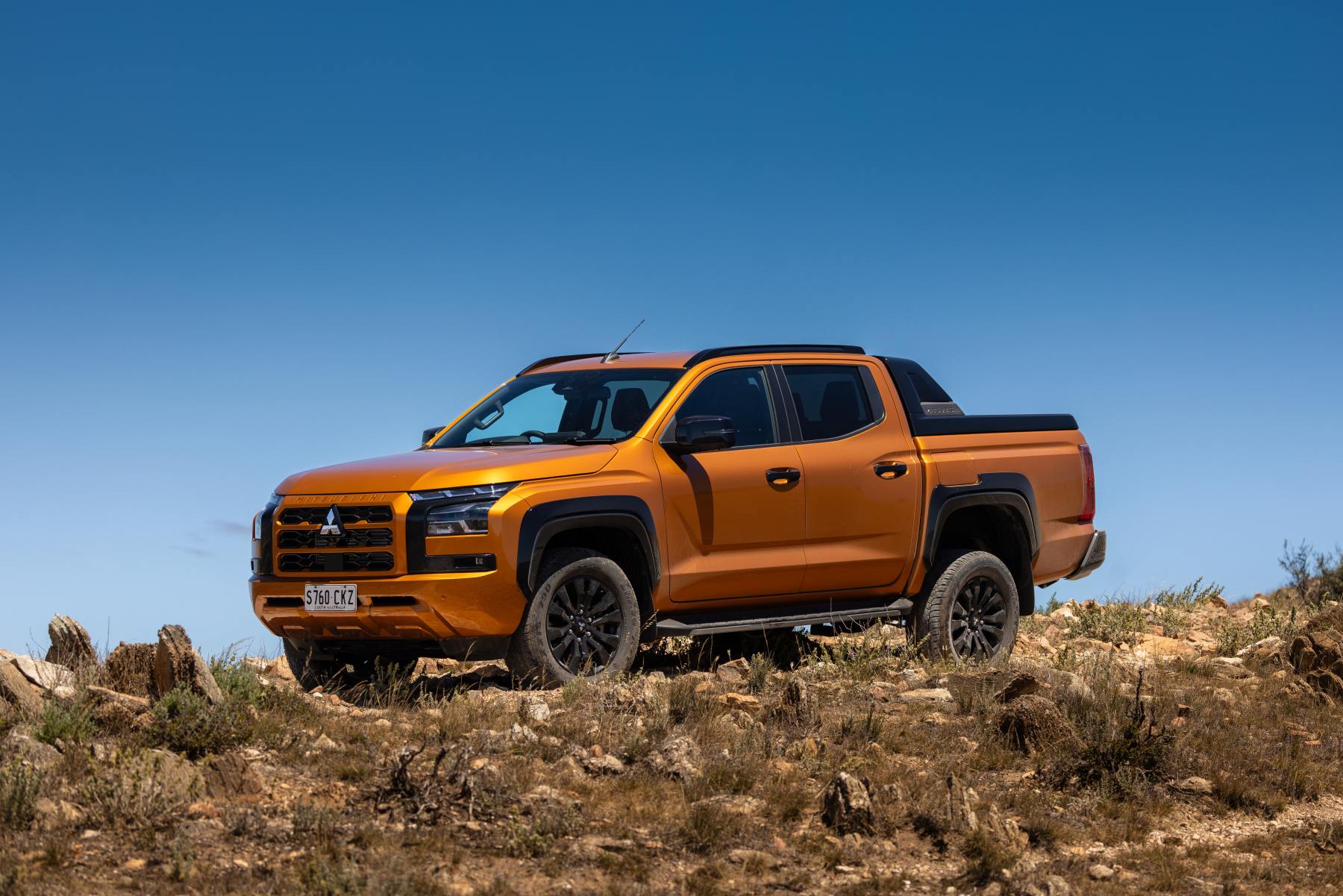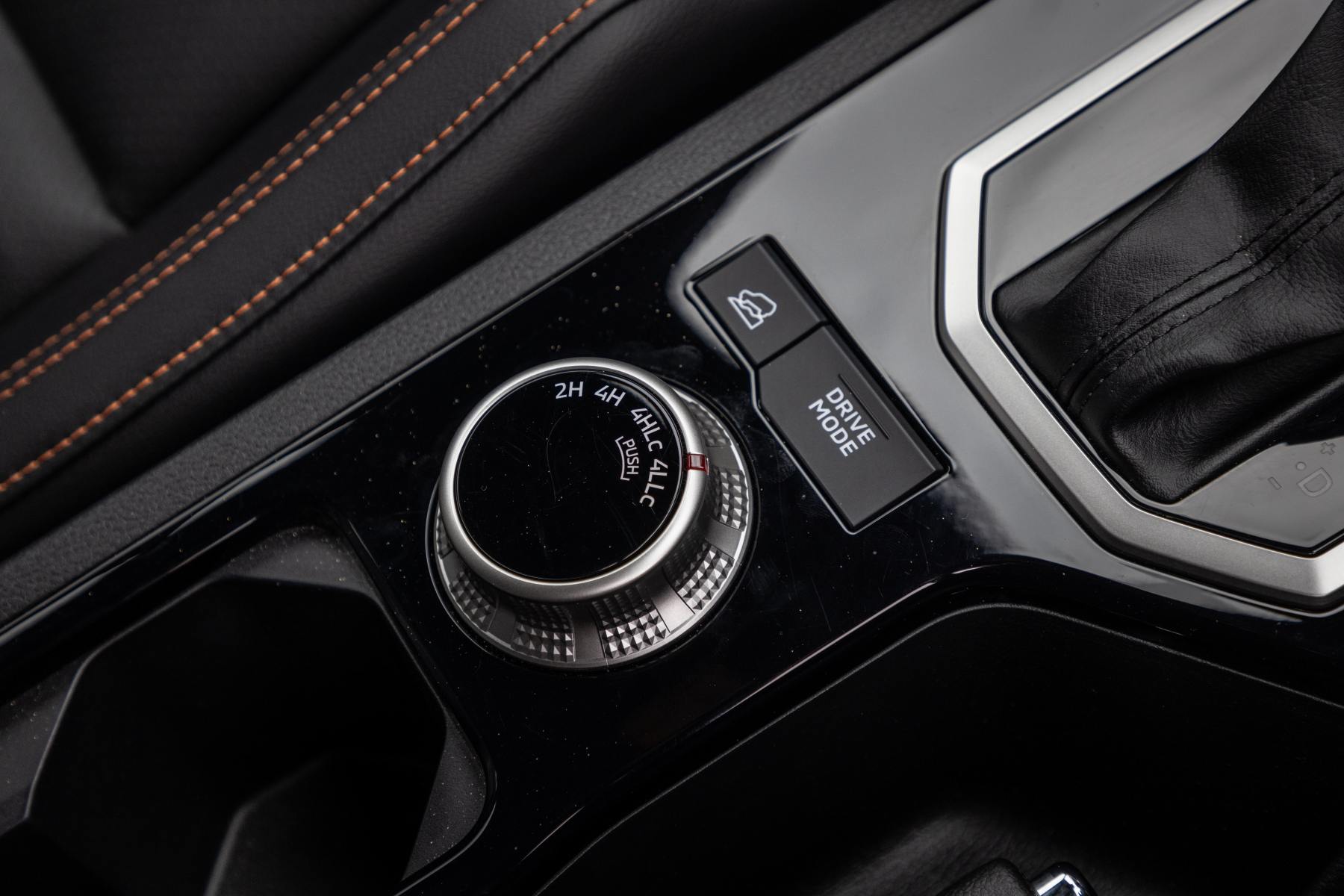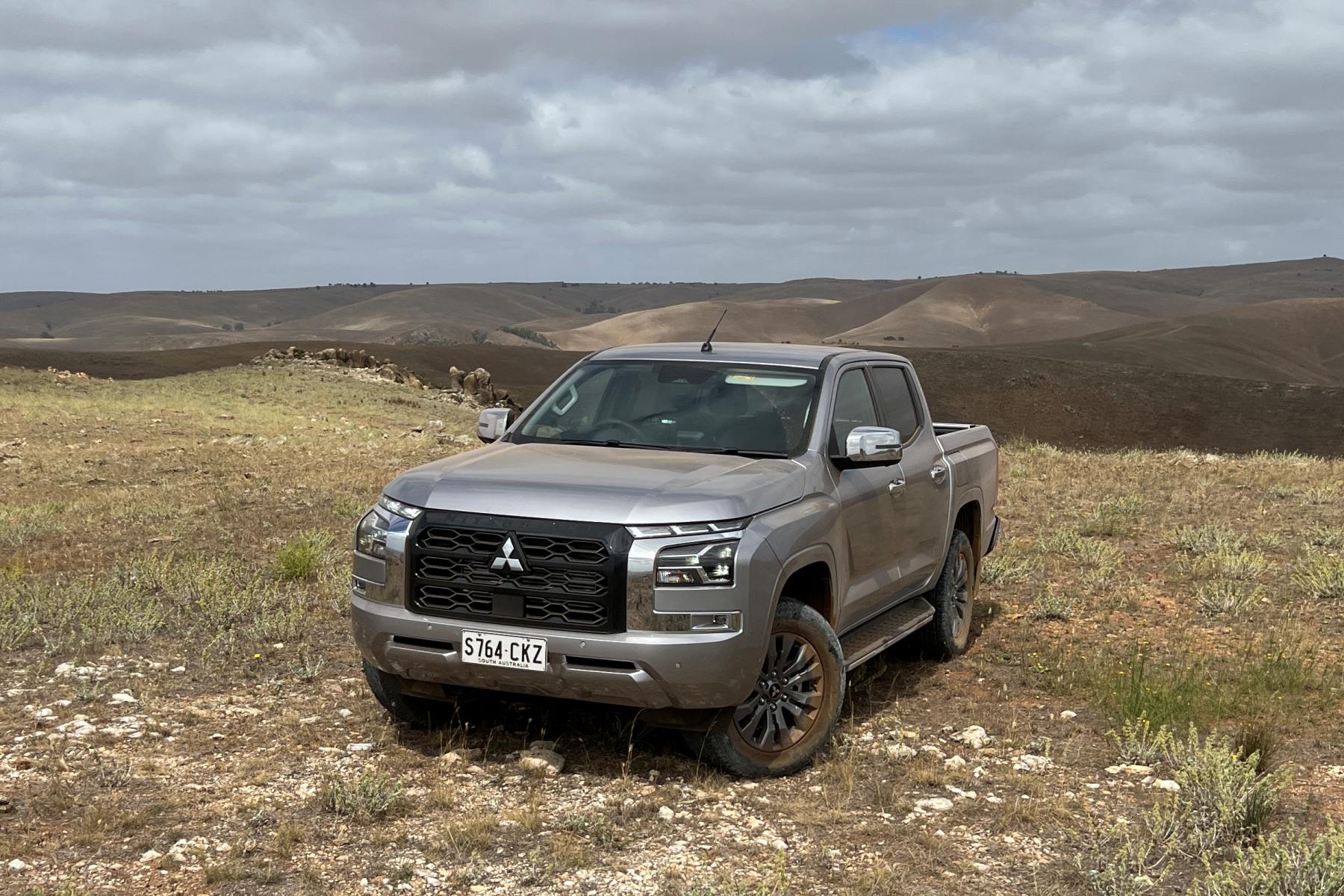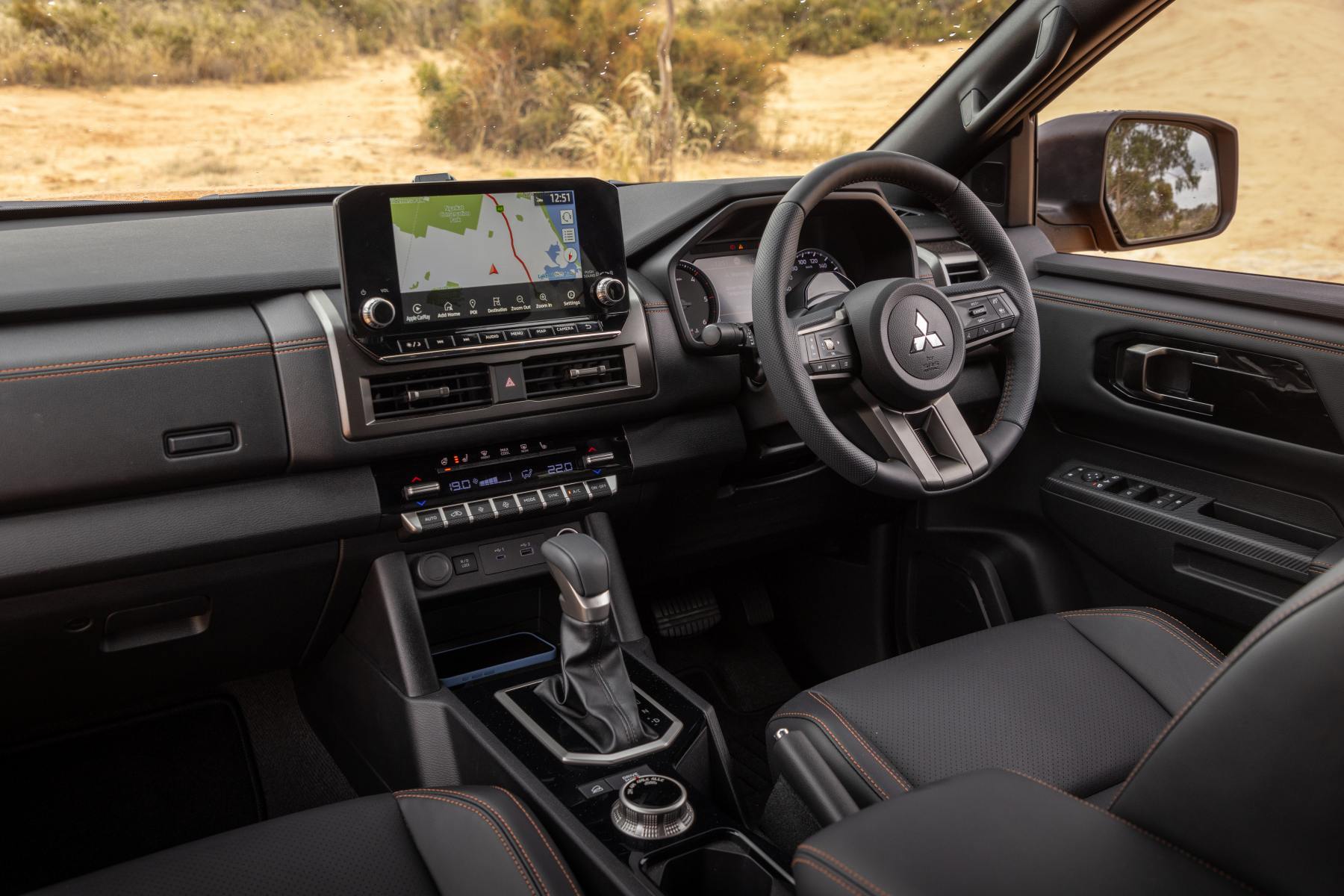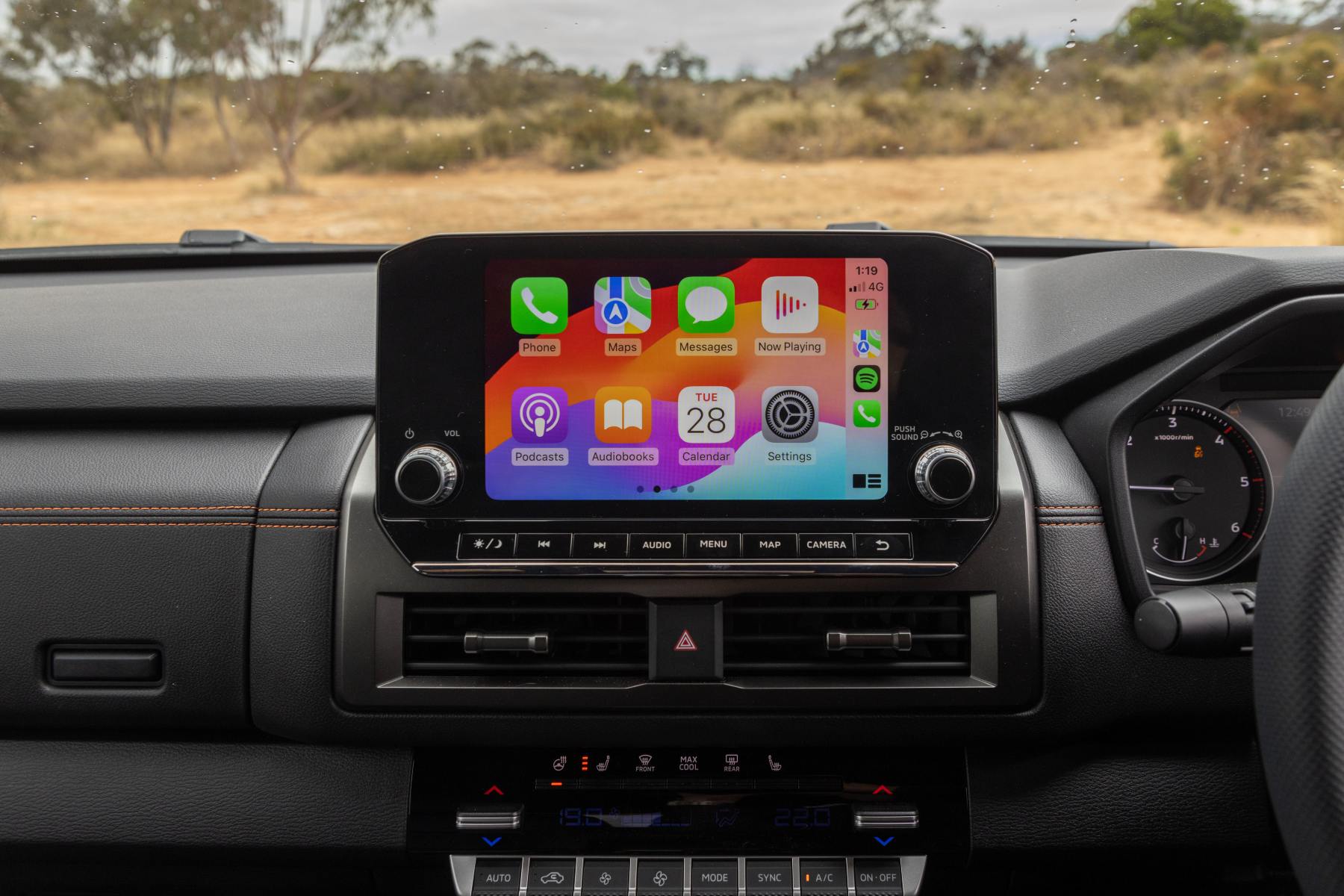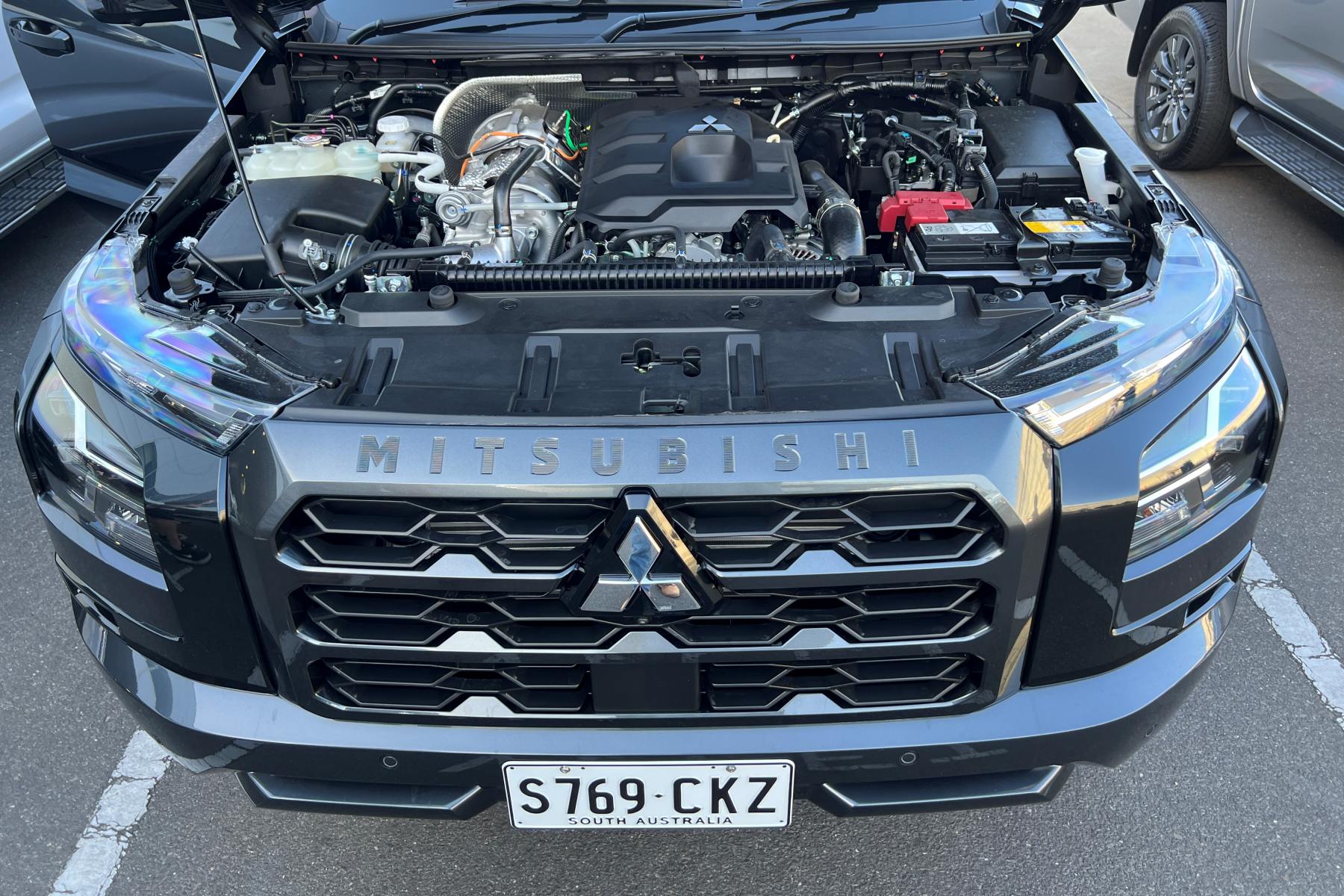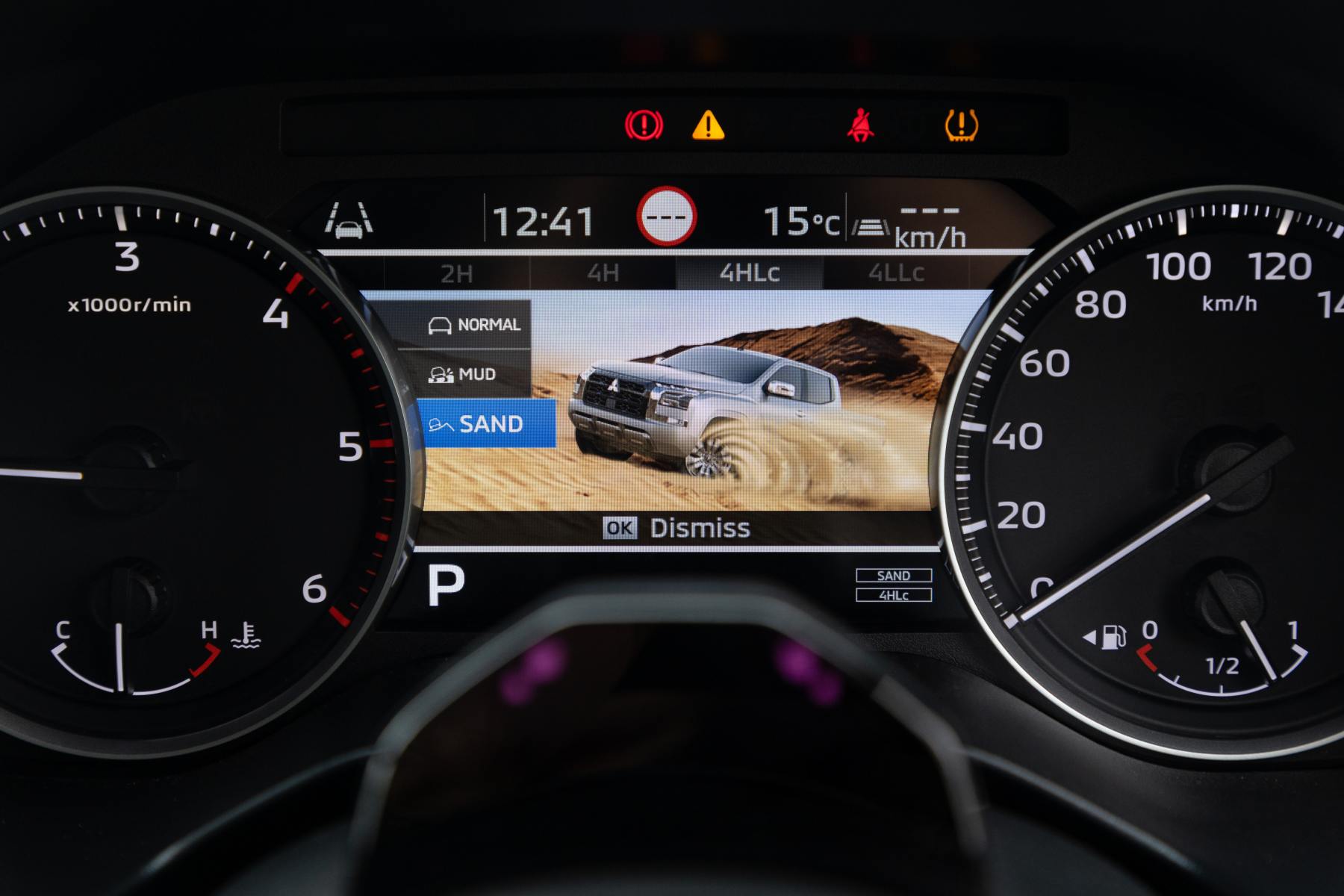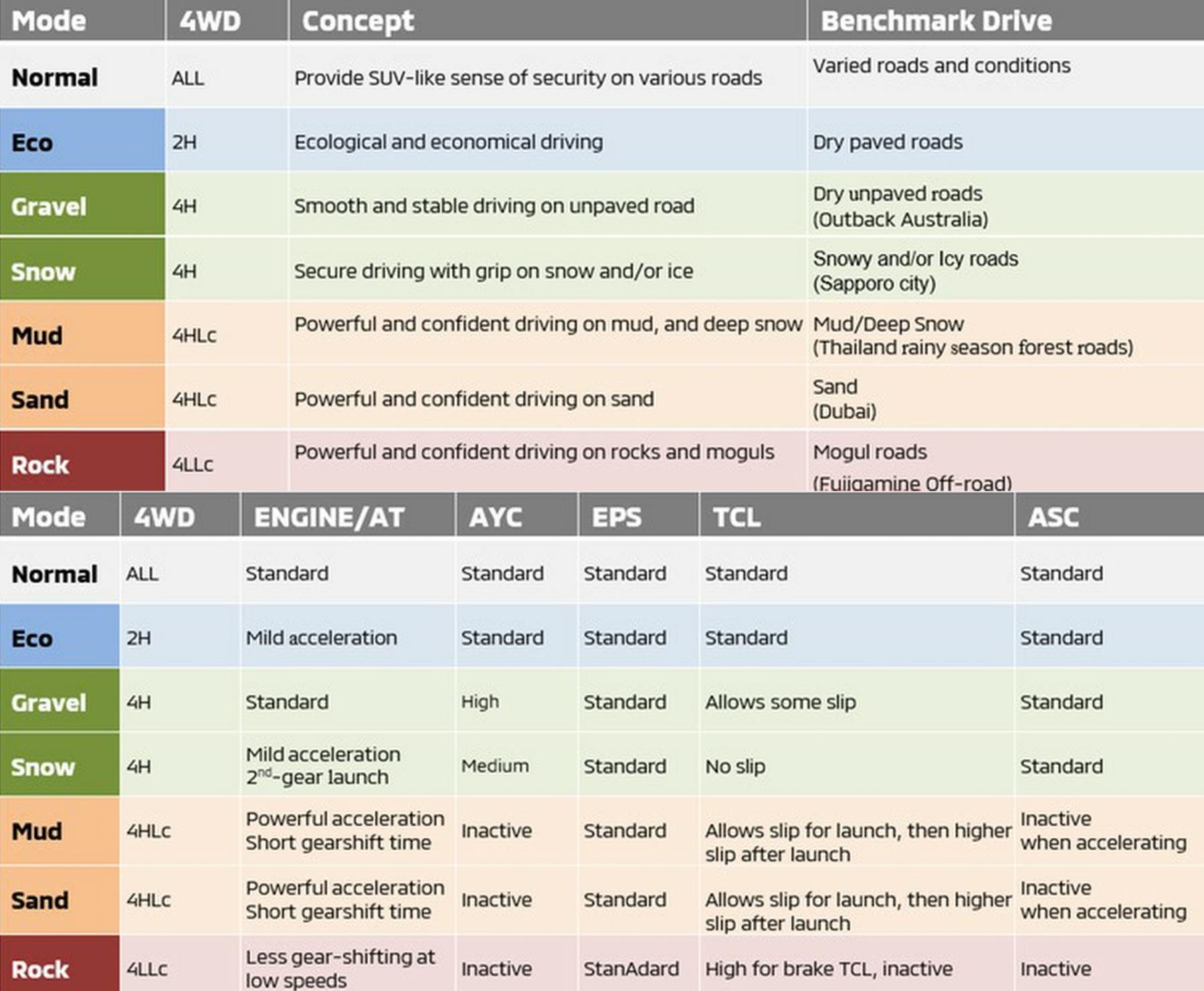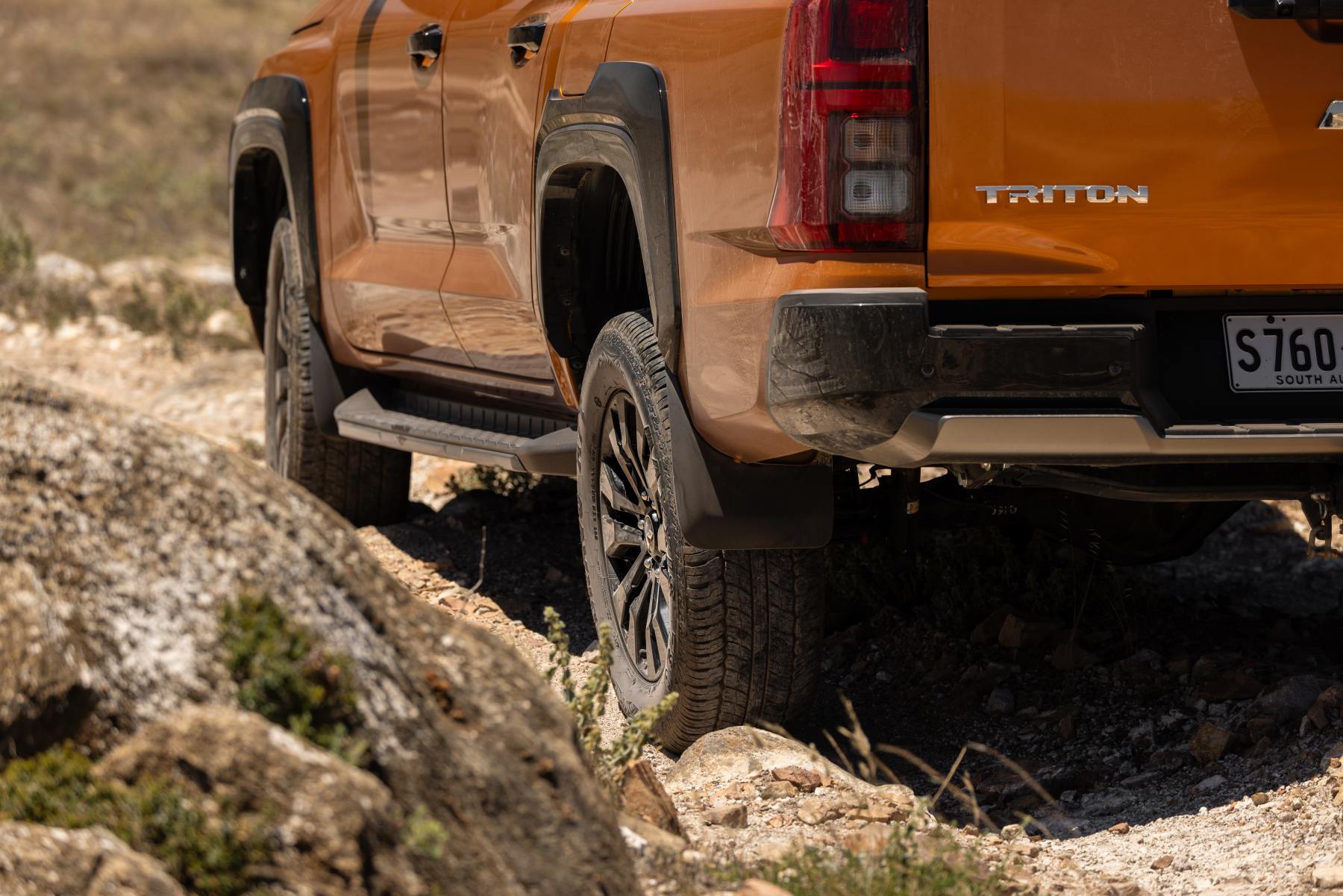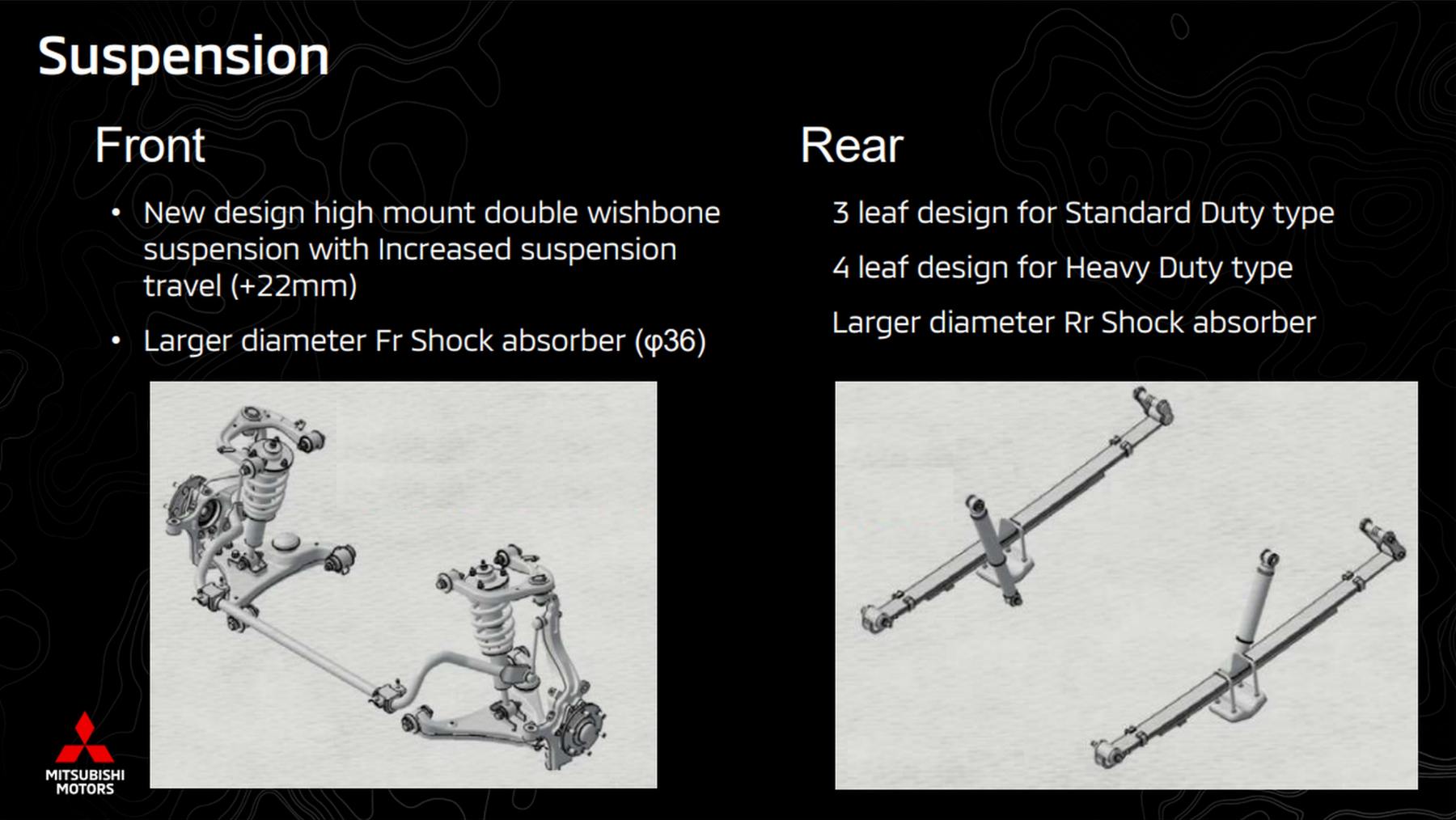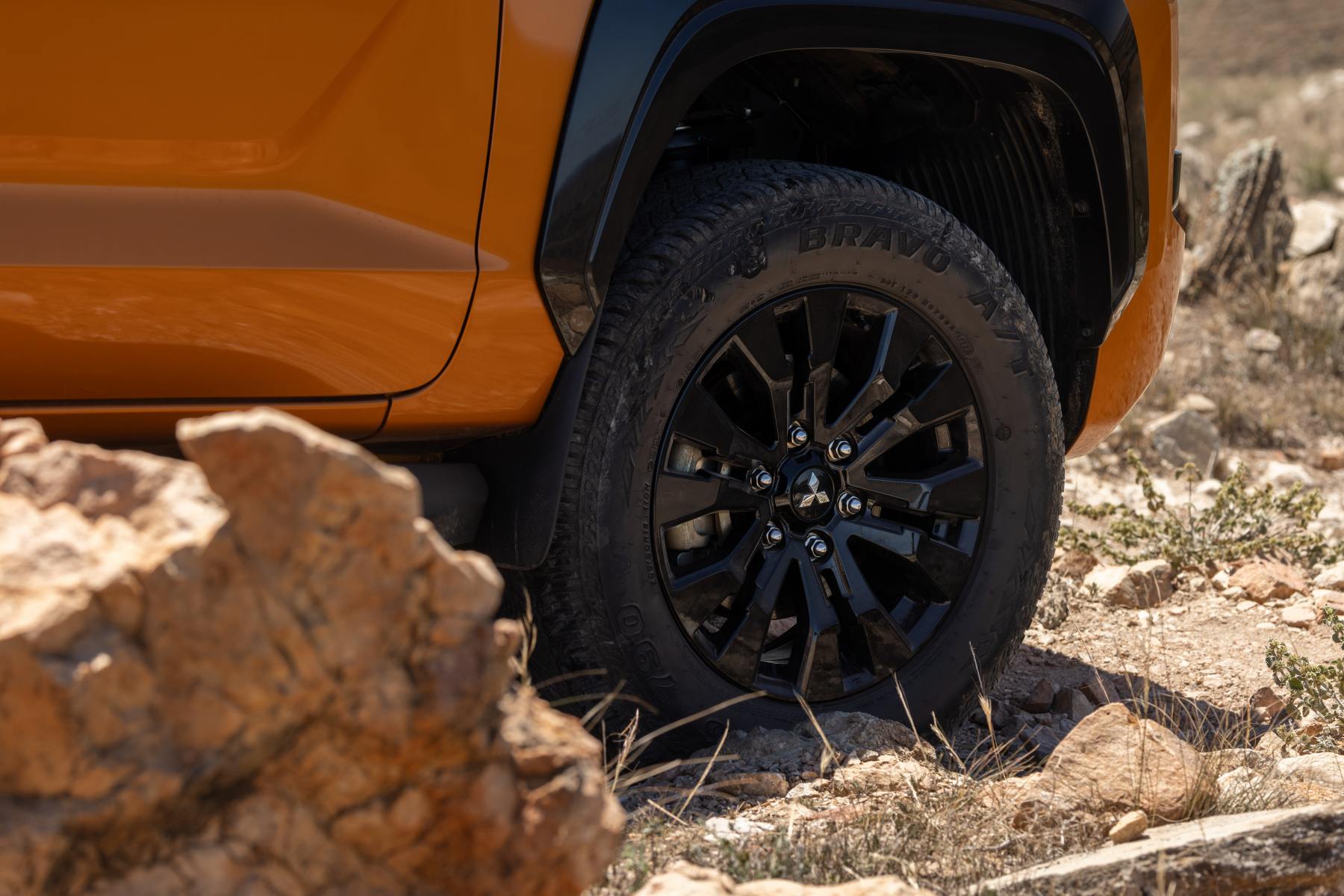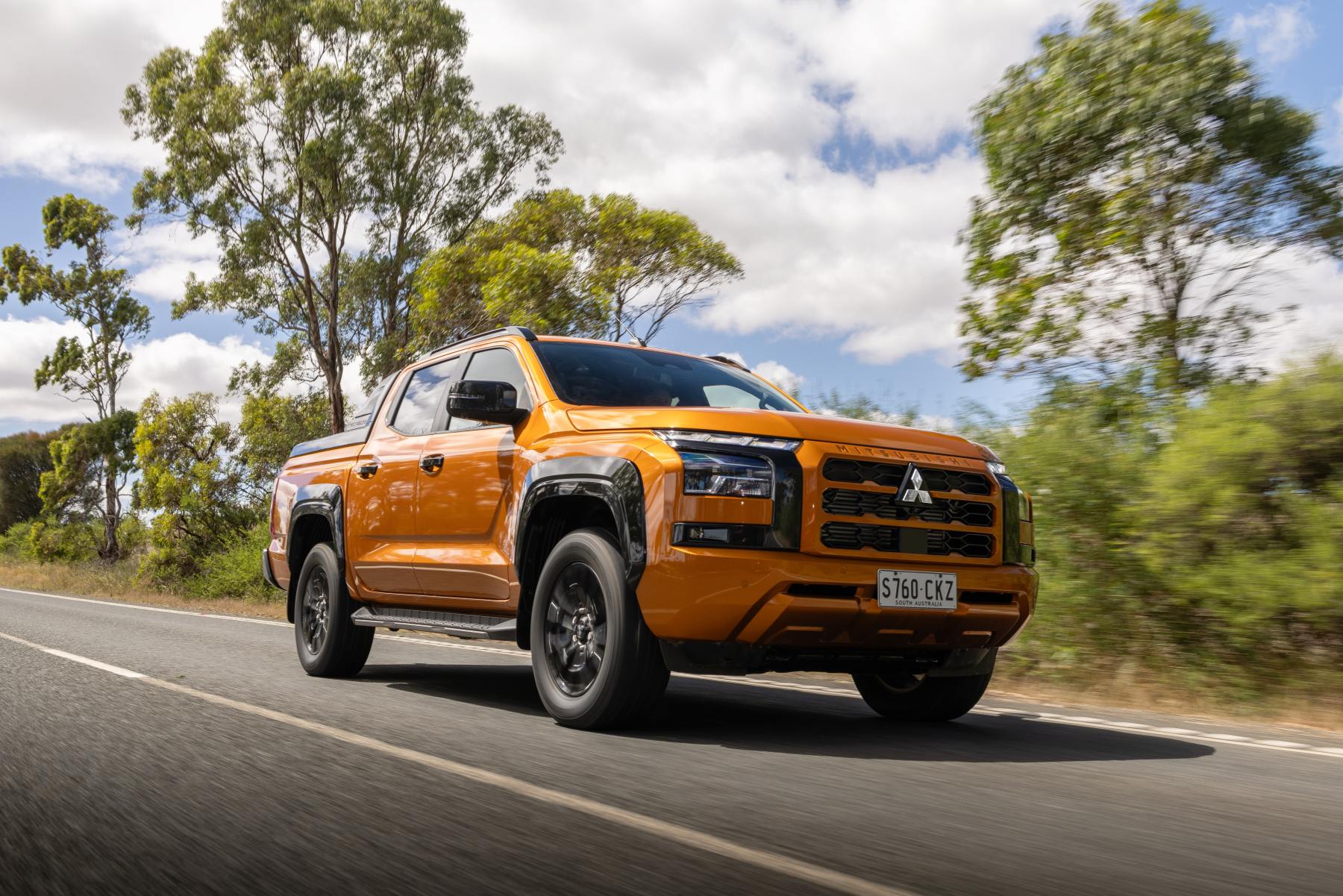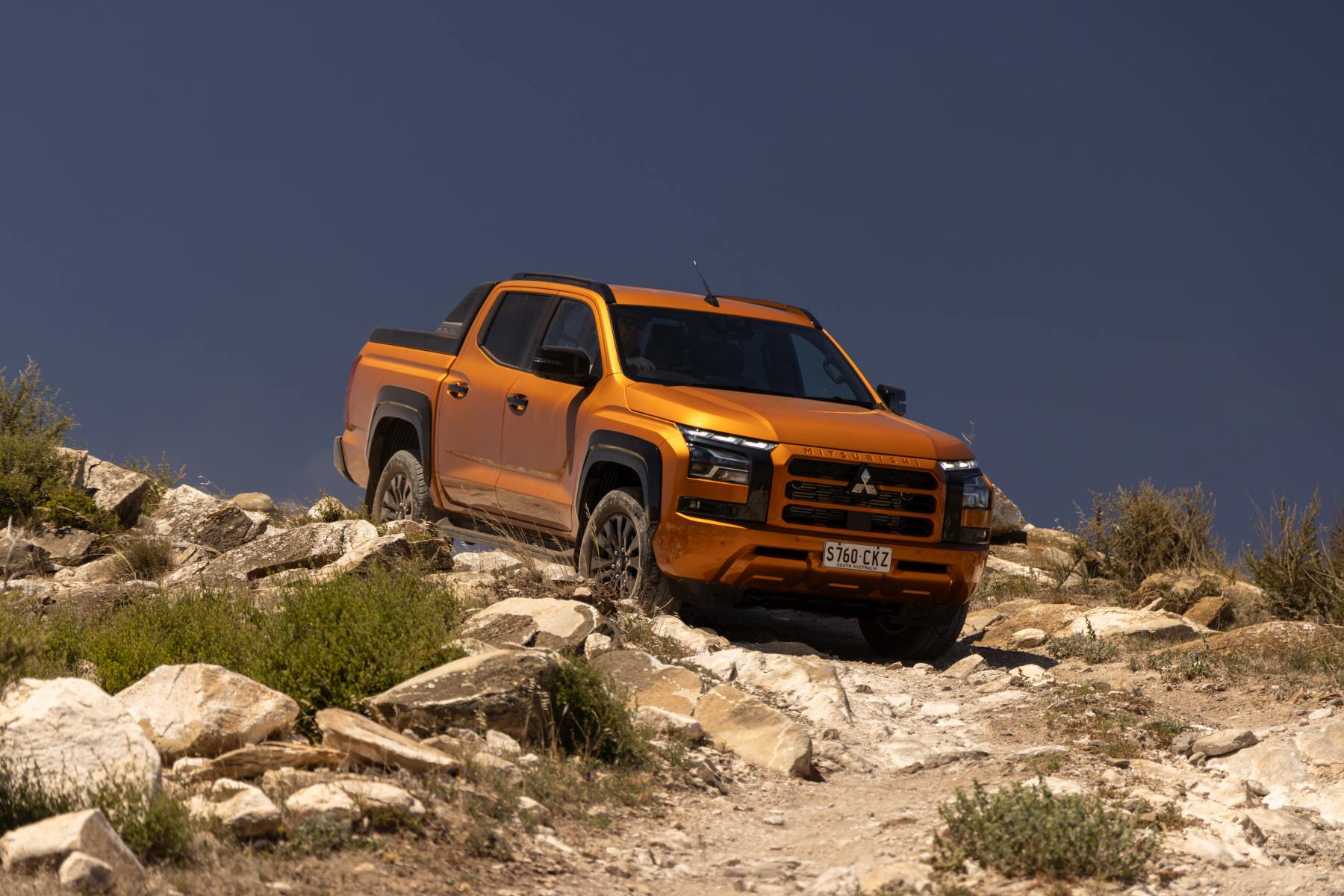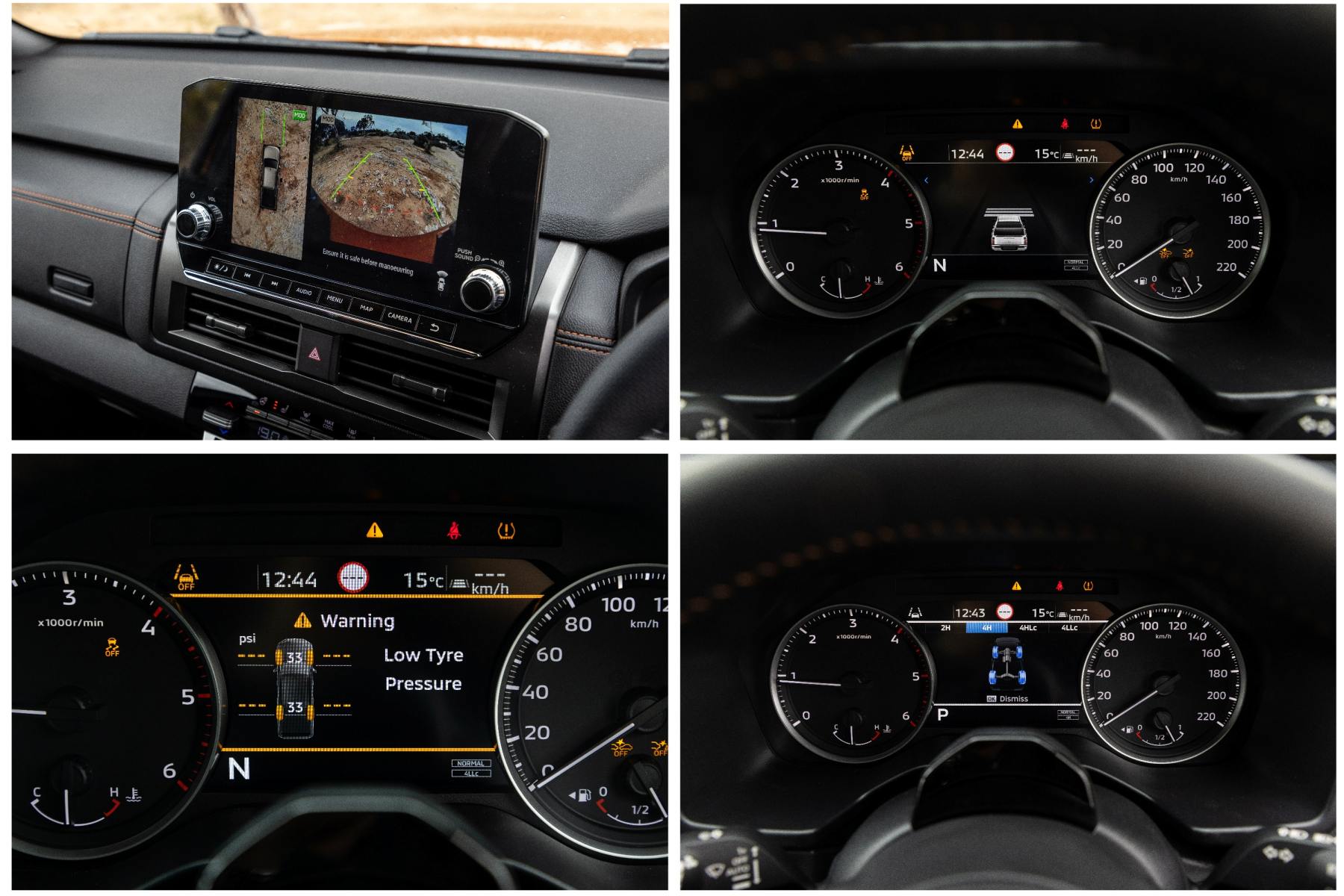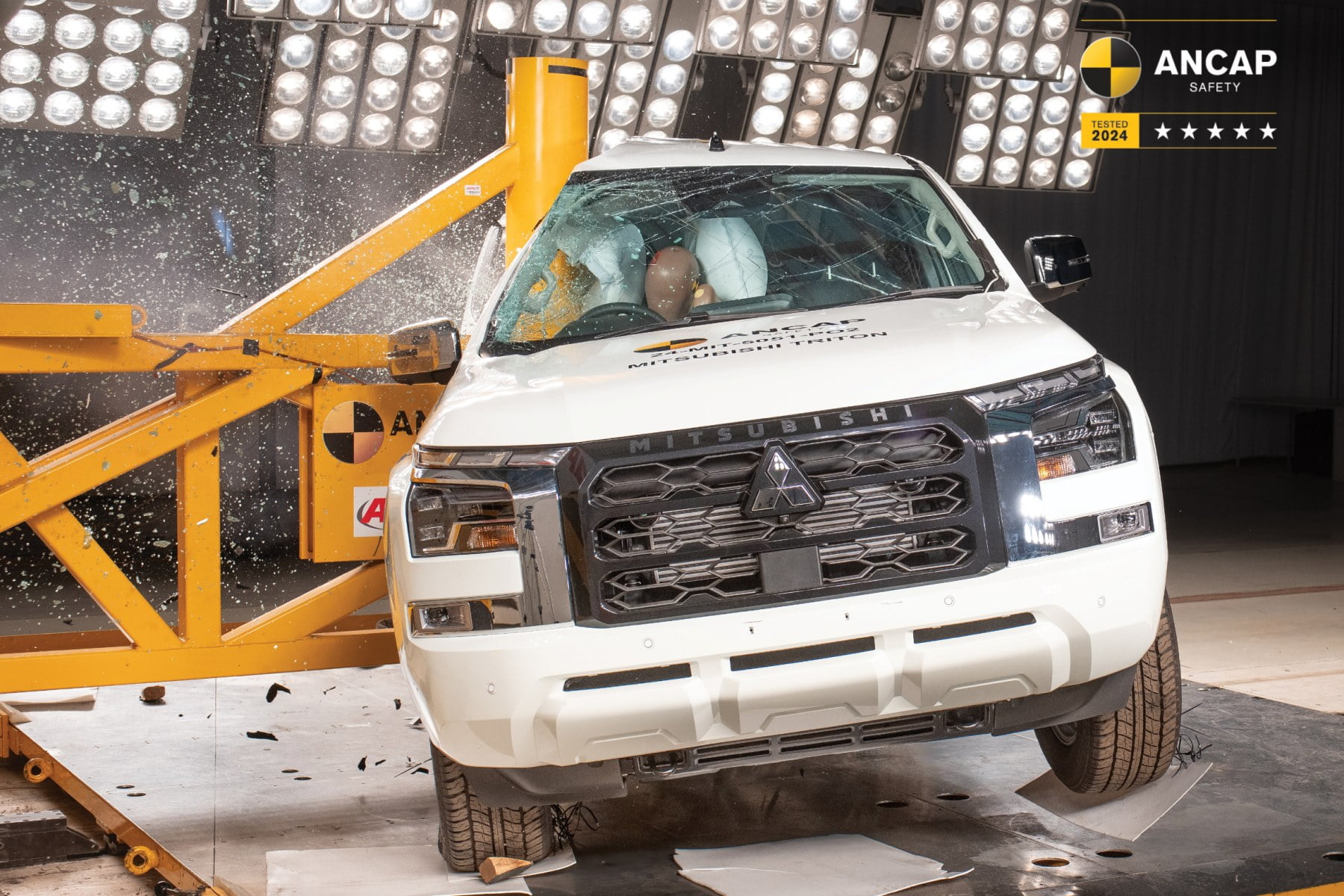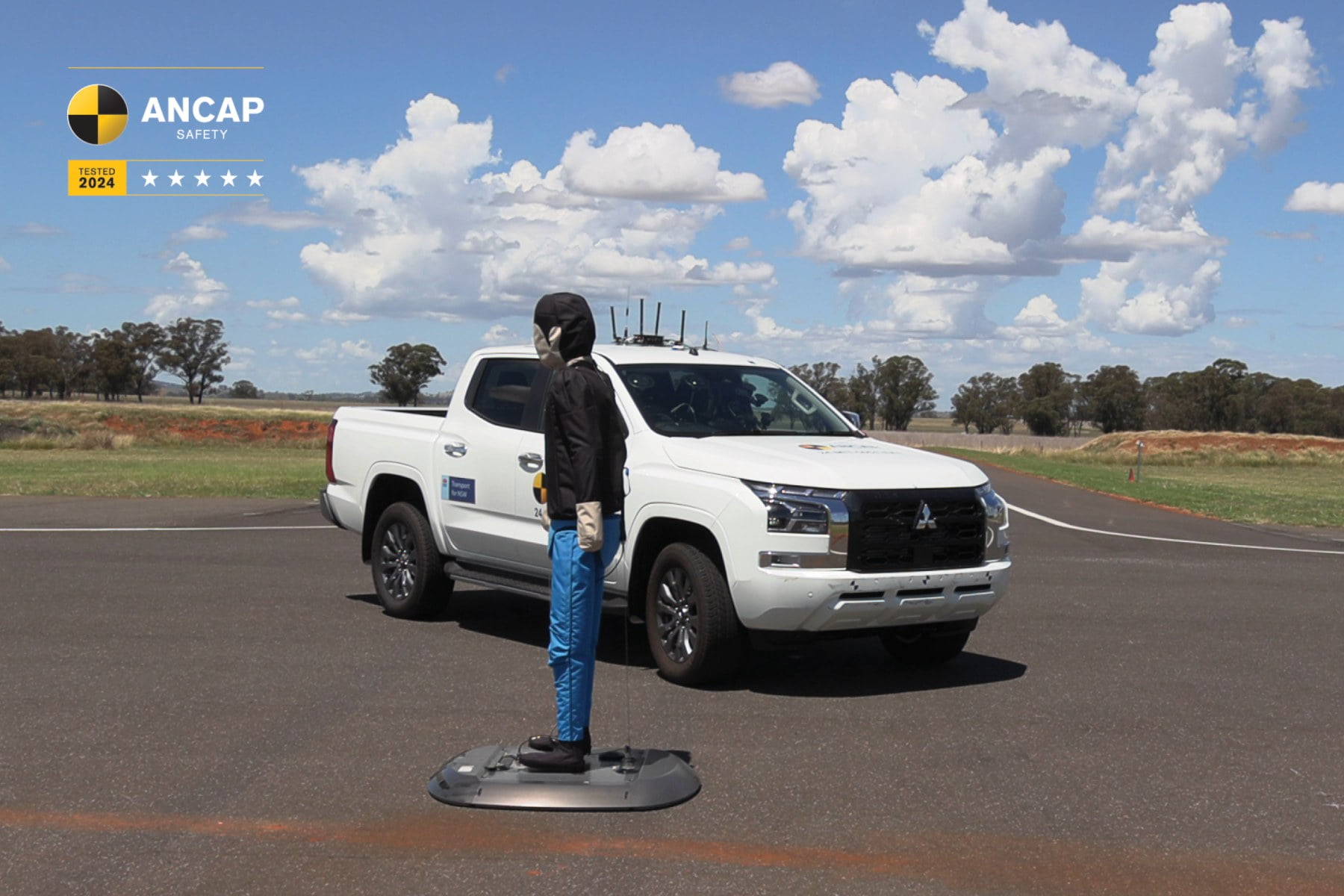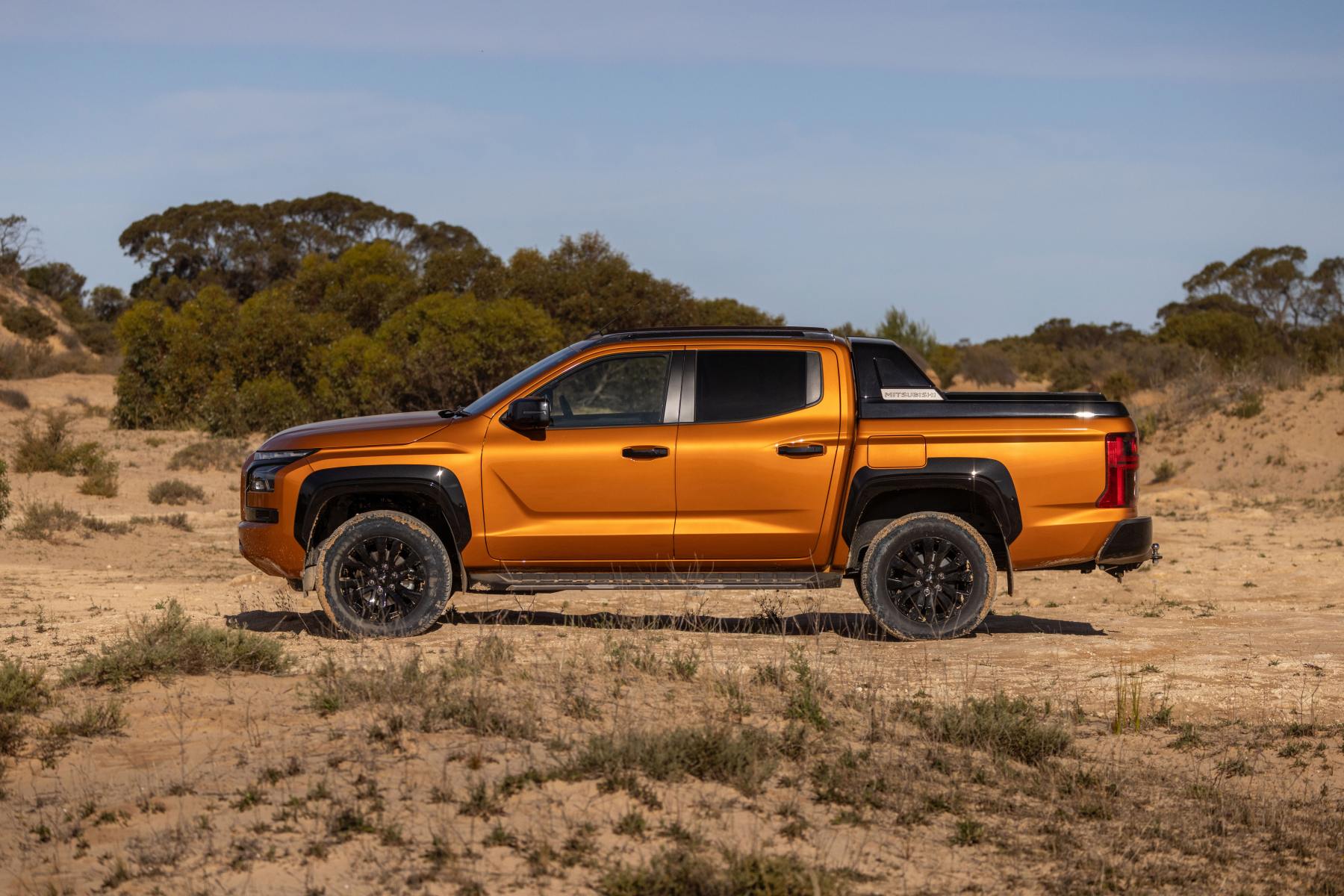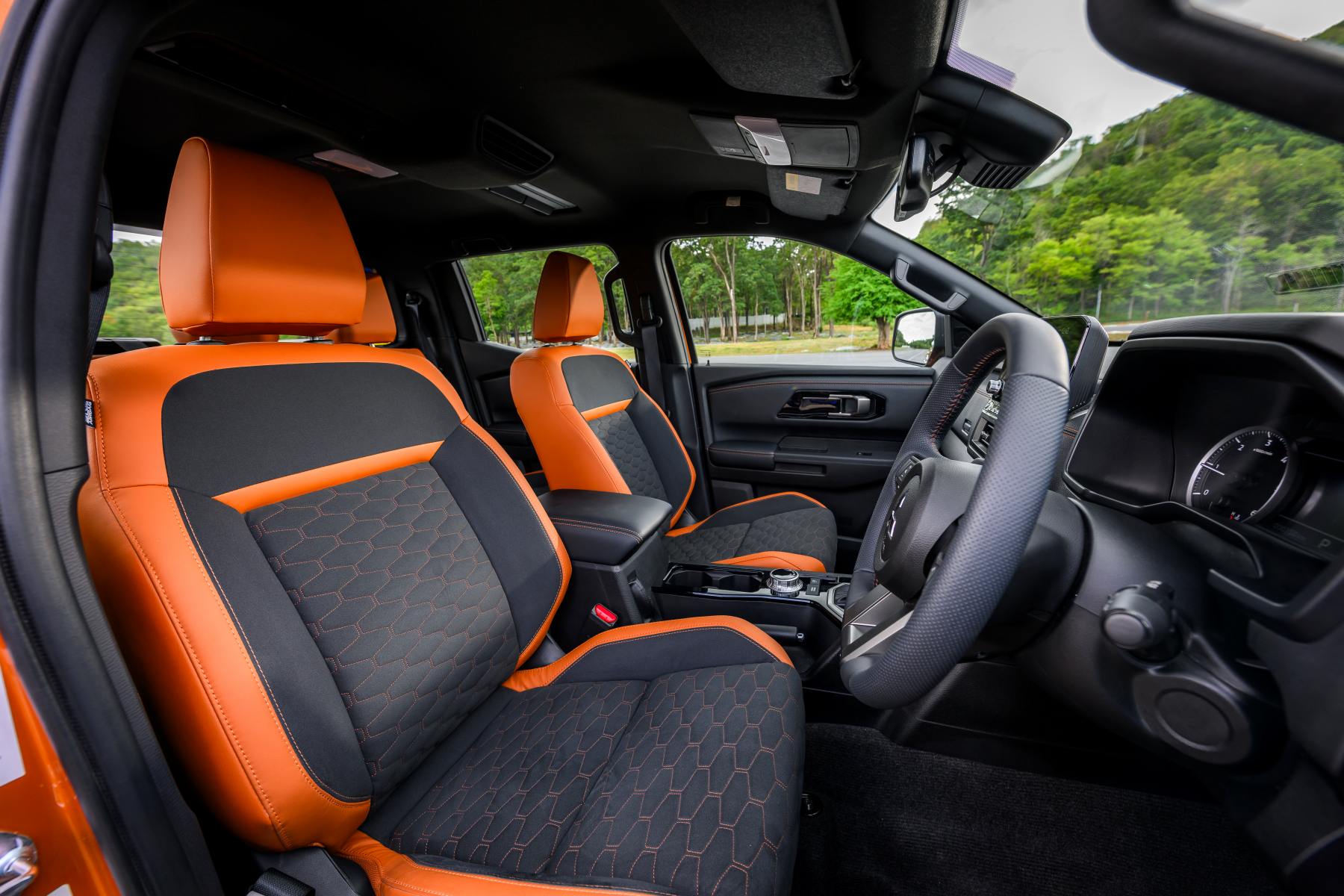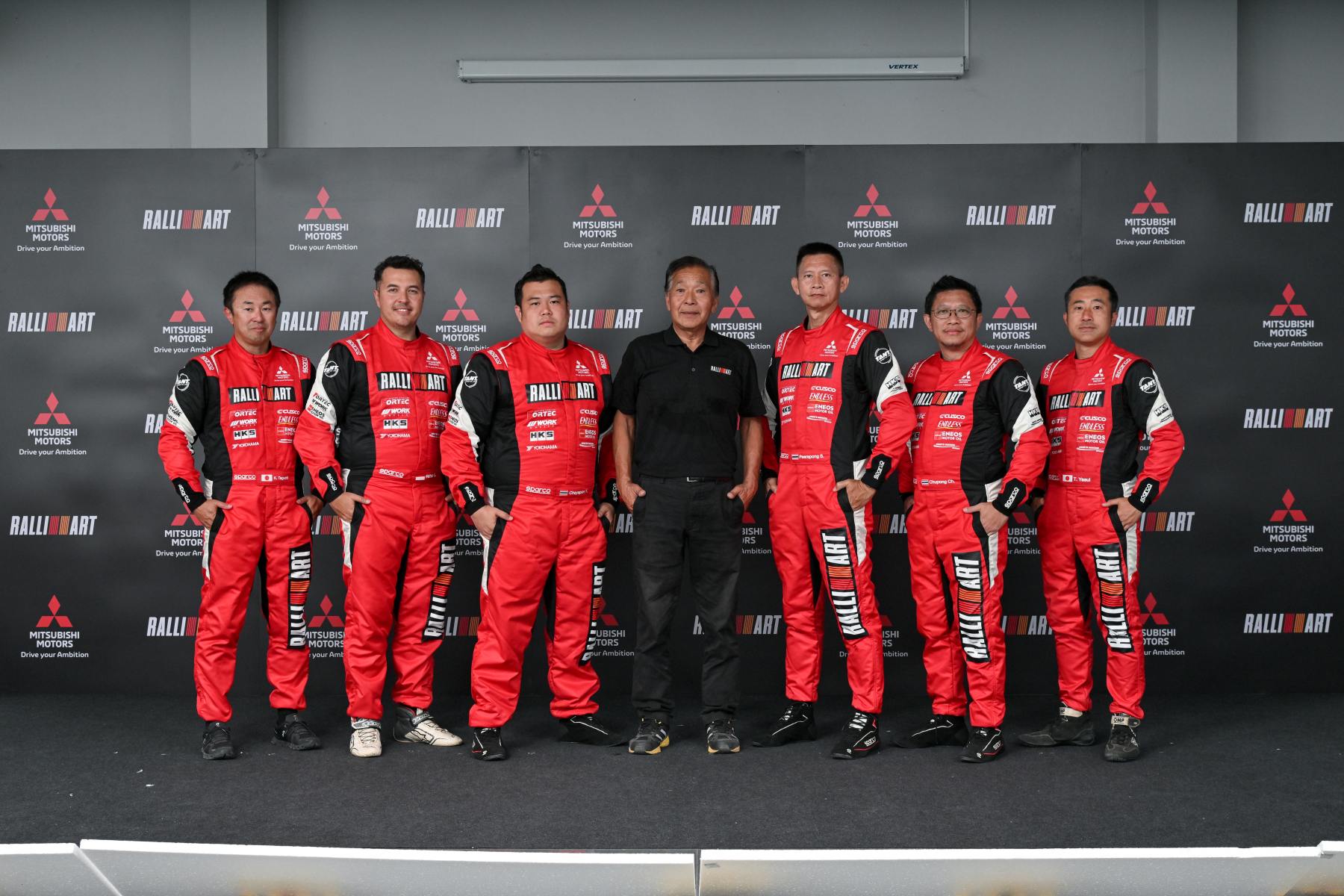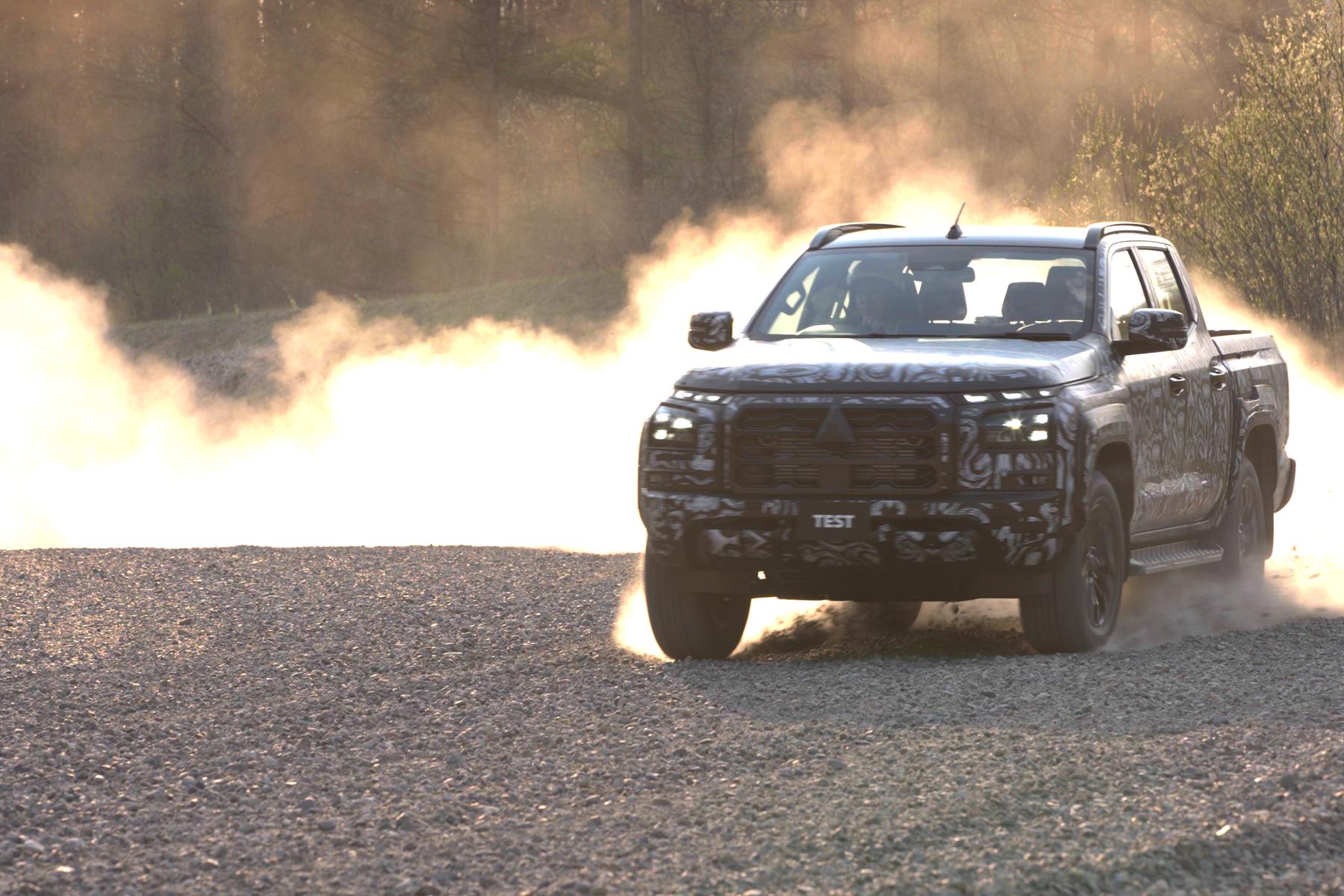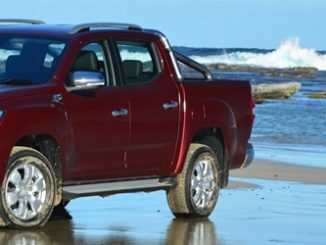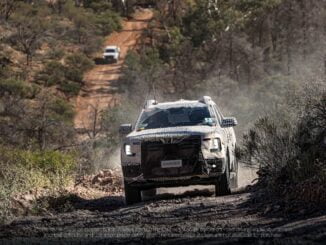Mitsubishi Triton First drive review 1st March 2024
Mitsubishi Triton has always been a reliable, robust and value based 4WD Ute that at times has been underrated by the market.
The all-new Triton should squash any doubts that buyers have about its ability to compete within the segment.
To coincide with the release of the Triton, Mitsubishi are also refocussing on the customer experience. Mitsubishi are looking to delivering a premium ownership proposition. From vehicle specification, quality and value to the dealership experience and aftersales support.
The Australian market is important to global sales, coming in third overall. In recognition of that, there has been extensive localised testing and improvements.
The launch models are the dual cab Pickup models only. Others will be coming a bit later.
TO LISTEN TO THE Mitsubishi Triton RADIO REVIEW, CLICK BELOW
Mitsubishi Triton Video Review
What is good? |
|
What is not so good? |
|
Instead of the Triton buyers could look at:
It’s a competitive segment.
There is of course the popular Toyota HiLux, Ford Ranger 2.0L, Isuzu D-Max, Mazda BT-50, Nissan Navara, SsangYong Musso, LDV T60,
So now we have driven it what’s the Triton like?
What does the new Mitsubishi Triton look like?
All new Triton is about 130mm longer in wheelbase and 50mm wider in track than the outgoing model.
It now takes on the bigger bolder American Pickup style with a high squared off grill and bonnet.
The grill dominates the appearance, which is direct contrast to the model it replaces.
The bonnet has a sense of purpose.
The squared look continues with the wheel arches that give the profile a muscular look, that flows through to the rear tailgate. One note is that the tailgate isn’t a soft open style, and it drops heavily. That’s an easy fix, but these days all manufacturers should have it as standard.
The other thing to note is that frontal tie points are high in the tub. Like a few others, that’s pretty useless. They are called tie DOWN points for a reason. If you have something flat, like a flat pack piece of furniture, you can’t actually tie it down to the bed.
However, you can fit a 1200mm pallet between the wheel arches with a tub liner installed. That’s practical.
Its chalk and cheese to the outgoing model. That look was a major part pf why the Ranger became so popular. Perhaps it will do the same for the Triton.
In any case I like the new style.
What is inside the Triton like.
A compete revamp. The old model was well and truly dated. It’s based on a 3 horizontal axis design.
Front seats are particularly comfortable, you sit well in them not on them. It’s a high seating position. All drivers’ seats across the range have electronic lumbar adjustment, which is awesome for my aging back.
In front of the driver is a thick, compact steering wheel that enhances the responsive feel of the Triton.
Drivers’ instruments are clear and easy to read with a traditional twin outer dial and middle MFD design.
You can cycle through the MFD for a multitude of information sets. Quite handy.
The central stack still has buttons, levers, and dials, which I like. They are well laid out but easy to use and you can find what you want quickly.
Often the digital replacements look fancy but aren’t as practical.
The Central touch screen has excellent resolution and touch sensitivity.
A personal note, I’m more a fan of an integrated style, rather than the stuck on top tablet style that is in the Triton. But others at the launch quite liked it so there’s that.
There is plenty of storage, the centre console can hold 6 bottles. Door trims hold large bottle and a folder. Like a few Utes now there are clever dash slide out cup holders on the GSR
Rear Occupants
The rear seats are especially comfortable. They tend to wrap around the outer two occupants. Like all Utes, the middle passenger isn’t so well looked after.
I sat in the rear for a longer drive and my 190cm frame that is larger than the average bear nestled in without fuss. Plenty of headroom, kneeroom and my upper shoulders and head was well supported.
Many Utes, even top spec models have a relatively flat rear seat, not so the Triton.
There are grab handles everywhere which helps entry and exit.
The all around visibility is pretty good, but you do notice the bigger frontal area and the ‘A’ pillar and external rear view mirror does form a slight blind spot.
What about Infotainment and connectivity technology
New-Gen Triton’s user interface is intuitively designed and thoroughly modern with a 9.0-inch digital touch screen fitted range-wide.
Featuring embedded satellite navigation with Android Auto and Wireless Apple CarPlay, as well as Bluetooth phone and audio, DAB and two USB inputs (1 x USB-A, and 1 x USB-C for the first time in Triton), New-Gen Triton seamlessly connects occupants to the outside world.
Charging devices on-the-go is also easier with Qi wireless smartphone charging making its Triton debut. Located in the centre console, this charging pad at a maximum of 15 watts.
A USB port rating increase from 1.5 to 2.4 amps (USB-A) and 3.0 amps (USB-C) further supports device charging.
A four-speaker audio system is standard on GLX and GLX+ models, while GLS and GSR receive premium six-speaker audio.
The dashboard meter ‘multi-information’ display grows from 4.2 inches in the previous generation to 7.0 inches in New-Gen Triton. Warning sounds are played through the speaker system rather than a buzzer as before, and the display now offers a wider range of information, including wiper mode, lighting status and the selected drive mode. It also greets occupants with a digital start up vehicle animation.
Also standard range-wide is the Multi Around Monitor, which utilises digital camera moving object detection, a wider view for both front and rear cameras and an improved bird’s eye view.
Mitsubishi Triton engine and drivetrain
The big news is the improved power and torque output for the Triton.
Still with the same 2.4L 4-cylinder engine that now comes with a bi-turbo. A smaller turbo to boost up to 1,000rpm, then the second kicks in for more top end performance.
The Triton now has 150kW of power @ 3,500 rpm and a handy 470 Nm of torque from 1,500 – 2,750 rpm. A headline figure of 500Nm would have been handy. But the torque comes in at a low 1,500 rpm and is flat through to 2,750 rpm. This means that its healthy, especially for towing and off road.
Overall there has been a 10% improvement in fuel economy as well
Mitsubishi has stuck with the proven 6 Sp Aisin sports automatic transmission. This matched with the clever Super Select 11 4WD system is a proven and robust combination.
The transmission has been fine tuned to match the wider drive modes available.
A six-speed manual will also be offered on some variants, post-launch.
A new engine Auto Stop & Go System further supports efficiency and a 17-litre AdBlue tank – a first for Triton – further reduces NOx emissions.
Triton drive modes
On 4 x 4 variants, a centre-console ‘DRIVE MODE’ button enables access to an even greater depth of capability.
As part of Triton’s overarching All Wheel Control system, there are seven available drive modes. These work in conjunction with Mitsubishi’s famed Super Select 4WD-II system, which continues to offer 2H, 4H, 4HLc and 4LLc drivetrain settings.
The tables below summarise New-Gen Triton’s All Wheel Control systems:
The ability to switch from high-range 2WD to 4WD on the fly has long been a hallmark of Mitsubishi’s 4WD systems.
In addition, the versatile Super Select 4WD-II system’s Torsen centre differential enables a 40/60 front/rear drive distribution when it is unlocked, giving strong traction on slippery surfaces without reducing on-road agility, even on dry sealed roads.
For even more traction and control when driving off-road, ‘4HLc’ – high-range four-wheel drive with locked centre differential – gives a 50/50 locked drive split, front and rear. The torque sensing centre diff has no bind. There is also active Yaw control.
‘4LLc’ utilises the transfer case to engage low-range gearing along with the locked centre differential. Using 4LLc also allows engagement of the rear differential lock, via an accessible console-mounted button, for maximum traction.
Couple of quick notes
- Engaging the rear diff locks turns off ASC on the front wheels
- Sand mode doesn’t automatically turn off ASC.
- Torque vectoring is for the front wheels only.
What is the upgraded suspension like?
First up let me say the ride and handling of the new Triton is significantly better. Its smoother and more compliant. There was minimal harsh rebound experienced on the test drive.
This was from a mix of motorway driving, back country roads, gravel roads and a multitude of testing 4WD conditions. I drove the Triton with no weight in the back, which usually means the ride is a bit bumpy, not so.
The improved ride was achieved through testing over 100 combinations of front and rear suspension options.
Specific changes are:
- increased front shock absorber diameter to complement the new, high-mount location for the front suspension’s upper wishbones.
- The new shock absorbers feature 36mm cylinders (compared to 32mm in the previous generation) for improved control,
- an impressive increase in rebound stroke length (from 68.4mm to 90.7mm) is also realised.
- In the rear, MMC engineers focused on reducing unsprung mass while improving strength through using high tensile spring steel.
- As a result, the standard rear suspension layout has reduced from five to three leaves; the heavy duty system from six to four.
- The first leaf remains the same thickness as before, while the additional leaves are of greater thickness.
- The rear shock absorber cylinders have also increased from 30mm to 36mm and feature a revised oil seal for additional strength and longer service life.
Wheel and tyre packages
The New-Gen Mitsubishi Triton’s significantly uprated suspension system is complemented by new-design 17- and 18-inch wheels.
The workhorse GLX 4 x 2 receives 17-inch steel wheels fitted with 265/65R17 highway-terrain tyres. While GLX 4 x 4 gains 265/65/R17 all-terrain tyres.
GLX+ benefits from a 17-inch alloy wheel design with 265/65/R17 all-terrains.
Moving to the premium GLS grade brings a sophisticated, multi-spoke alloy wheel design wrapped in 265/60/R18 highway rubber.
The flagship GSR gains a unique black-finish alloy of similar design.
What is the new Triton like to drive?
On road
In summary its significantly better on road and gravel surfaces.
This comes from a combination of factors that all add marginal improvements that add up to major improvements. It’s the jigsaw philosophy.
The electronic power steering is leaps and bounds ahead of the old model. It has particularly good responsiveness and the feel of the smaller, thick rimmed steering wheel adds to the improved feel.
I would have to drive it back to back with some others, but the steering response would go close to best in class.
Longer and wider chassis means that the Triton adopts a wider stance and feels more connected to the road. Its smoother and quieter as well
Revised suspension keeps everything tidy. Mid corner bumps, when at reasonable speed will result in a slight skipping, but overall, its way better than the previous model.
Higher outputs from the engine, and low delivery of torque also means more responsiveness and relaxed driving. It’s not a sports Ute but will hum along nicely when asked.
I’m a driver that likes to turn off driver assist features as I find many of them intrusive. It takes steps to turn off the facial recognition settings and driver assistance. Unfortunately, you need to do that every time you start the engine.
Off road
Off road on the 4WD trails and testing track, the Triton felt always composed. It did scrape its belly once or twice. But that is to be expected of a standard Ute where we went.
We tested the Triton on a couple of rutted, soft dirt inclines with deep mogul style holes. These are designed to test wheel articulation and grip.
The traction control system, when left to its own devices performed better than locked rear diffs on occasions.
On steep dirt descents, we tested both Low rage with the transmission locked in M1 and alternatively, the hill descent control. Both worked a treat.
The hill descent could well be close to best in class. It went about its business effortlessly and quietly. No complaining, burping or farting like many others.
I have to say though that the efficiency of low range M1 transmission, would mean that it wouldn’t get much use.
The higher torque output means that more of the control rests directly on your right foot and that’s a good thing.
In tight spots where visibility is restricted the surround camera is a bonus to help with wheel placement and detecting obstacles.
The overall impression is that the new Triton is a particularly tidy unit indeed.
Triton Safety Features – Update from ANCAP 12 April 2024
- New-Gen Mitsubishi Triton achieves maximum five-star ANCAP safety rating, tested to the latest – and most stringent – 2024 protocols
- New-Gen Triton is the first Dual-Cab Utility to be awarded the 2024 five-star ANCAP safety rating
- ANCAP noted extensive airbag array and advanced active safety systems as key standard equipment that supported the five-star rating
- Five-star ANCAP rating applicable to all Triton Dual Cab model grades, in 4 x 2 and 4 x 4 forms
- New-Gen Triton scored 89% for Child Occupant Protection, 86% for Adult Occupant Protection, 74% for Vulnerable Road User Protection and 70% for Safety Assist
New-Gen Triton Dual-Cab Utility has achieved the maximum five-star ANCAP safety rating, tested to the latest – and most stringent – 2024 protocols.
The five-star rating is applicable to all Triton Dual-Cab model grades, across 4 x 2 and 4 x 4 drivetrains.
“Safety is always a priority for Mitsubishi Motors,” said MMAL CEO, Shaun Westcott.
“To be the first Dual Cab Utility to achieve the stringent 2024 five-star ANCAP safety rating is testament to this, and proves how serious Mitsubishi is about safety.
In introducing its five-star rating, ANCAP referenced Triton’s extensive airbag installations, including dual frontal, side chest-protecting and side head-protecting, driver’s knee, and centre airbags. These are fitted as standard across the range.
ANCAP also mentioned the extensive active safety suite, including AEB (car-to-car, Vulnerable Road User, junction and backover), as well as the lane support system with Lane Keep Assist, Lane Departure Warning and speed sign recognition.
New-Gen Triton scored highly across each key ANCAP category, as below:
89% Child Occupant Protection
86% Adult Occupant Protection
74% Vulnerable Road User Protection
70% Safety Assist
A full copy of ANCAP’s technical report is available here: http://ancap.link/s/08109a
New-Gen Mitsubishi Triton: List of Safety Systems
Passive Safety
- Driver and passenger front airbags
- Centre airbag
- Driver and front passenger side airbags
- Driver’s knee airbag
- Curtain airbags
Active Safety Assist Technology
- Forward Collision Mitigation (FCM) with:
- Pedestrian detection
- Cyclist detection
- Junction assist
- Adaptive Cruise Control (ACC)
- Blind Spot Warning (BSW)/Lane Change Assist (LCA)
- Emergency Lane Keeping (ELK)
- Emergency Lane Assist (ELA)
- Lane Departure Prevention (LDP)
- Parking sensors – front and rear
- Rear view camera
- Front Cross Traffic Alert
- Rear Cross Traffic Alert
- Multi Collision Brake
- Traffic Sign Recognition (TSR)
- Driver Attention Alert (DAA)
- Driver Monitor System (DMS)
- Intelligent Speed Limiter (ISL)
- Automatic High Beam system (AHB)
- Rear AEB (GLX+, GLS and GSR)
Active Safety Assist Technology – Braking and Stability:
- Active Stability Control (ASC)
- Anti-Lock Braking System (ABS)
- Traction Control
- Electronic Brake Distribution (EBD)
- Brake Assist system
- Trailer Stability Assist (TSA)
- Hill Start Assist (HSA)
- Emergency Stop Signal (ESS)
Warranty And Servicing
Mitsubishi advertises a Diamond Advantage with Australia’s only 10/10 warranty and capped price servicing program*
Australia’s only 10/10 Diamond Advantage offering will continue for New-Gen Triton. New Triton owners are ensured peace-of-mind with a 10-year warranty and 10-year capped price servicing program.
Roadside assist is also included for 12 months from purchase, renewed for another 12 months when the vehicle is serviced in accordance to the capped price servicing program for a maximum of four years, post-purchase.
Featuring 12-month / 15,000km service intervals as before, New-Gen Triton benefits from several enhancements (including removing the need to set tappet clearances every 60,000km) that reduce servicing costs over the 10-year term, compared to the previous generation.
| Model | 15K | 30K | 45K | 60K | 75K | 90K | 105K | 120K | 135K | 150K | Total |
| 23MY Triton 4×4 | $449 | $549 | $549 | $799 | $549 | $799 | $549 | $999 | $699 | $799 | $6740 |
| New-Gen Triton 4×4 | $489 | $489 | $489 | $489 | $489 | $799 | $749 | $949 | $849 | $899 | $6690 |
*Up to 10 years from the date of first registration or 200,000 km New Vehicle Warranty (whichever comes first) when all regular services are completed within the specified service intervals at a Mitsubishi Dealership. Otherwise, 5 years from the date of first registration or 100,000 km New Vehicle Warranty (whichever comes first) applies.
Triton Specifications
Launch model range: Something for everybody
New-Gen Triton follows the Triton tradition, with a wide range of model grades designed to cater to every need.
At launch, Double Cab Pickup variants will be available, with Club Cab and Cab-Chassis variants to be added later in 2024.
New-Gen Triton follows a highly recognisable model structure, offering GLX, GLX+, GLS and GSR grades, and all are comprehensively equipped as standard.
*Please note, a comprehensive per-model specification panel is provided at the end of this press kit.
Triton GLX
The value-packed workhorse of the range, Triton GLX features:
Drivetrain and Chassis:
- Engine Auto Stop & Go system
- Heavy Duty rear suspension
- Easy Select 4WD (4×4 models)
Exterior:
- All new exterior design
- Front engine metal sheet undercover (4×4 models)
- Front engine composite sheet undercover (4×2 models)
- New 17” steel wheels
- MITSUBISHI embossed material black Grille
Interior:
- All new interior design
- Cloth seat trim
- Floor console box with lid
- 2x cup holders, 2 bottle holders and sunglasses holder
- Driver sun visor with ticket holder
- Driver seat electric lumbar support
- Vinyl Floor
- Seat back pocket including phone and tablet storage (Double Cab)
- 2nd row bench seat (Double Cab)
- 2nd row arm rest centre with cup holder (Double Cab)
Passive Safety:
- Driver and passenger front airbags
- Centre airbag
- Driver knee airbag
- Driver and front passenger side airbags
- Curtain airbags
Active Safety Assist Technology – Collision warning and avoidance:
- Forward Collision Mitigation (FCM) with:
- Pedestrian detection
- Cyclist detection
- Junction assist
- Rear Automatic Emergency Braking
- Adaptive Cruise Control (ACC) AT models
- Blind spot Warning (BSW)/Lane Change Alert (LCA)
- Emergency Lane Assist (ELA)
- Lane Departure Warning (LDW)
- Lane Departure Prevention (LDP)
- Parking sensors – front and rear
- Front Cross Traffic Alert (no cost dealer-fit option)
- Rear Cross Traffic Alert
- Multi Collision Brake
- Traffic Sign Recognition (TSR)
- Driver Attention Alert (DAA)
- Driver Monitor System (DMS)
- Adjustable Speed Limitation Function – Auto type (TSR+Navi)
- Automatic High Beam system (AHB)
Active Safety Assist Technology – Braking and Stability:
- Active Stability Control (ASC)
- Anti-Lock Braking System (ABS)
- Traction Control
- Electronic Brake Distribution (EBD)
- Brake Assist system
- Trailer Stability Assist (TSA)
- Hill Start Assist
- Emergency Stop Signal (ESS)
Comfort and Convenience:
- Manual Air Conditioner (Single Cab)
- Automatic Air Conditioner (Club Cab & Double Cab)
- Tyre pressure Monitoring System (TPMS)
- Electric Power Steering (EPS)
- Steering wheel haptic (Lane Departure Warning)
- 7” LCD MID Meter Cluster
- Integrated Navigation System
- Multi Around view Monitor
- 1 front USB-A port
- 1 front USB-C port
Audio:
- 9” audio display
- Wireless Apple CarPlay
- Android Auto
- 2 speakers (Single Cab)
- 4 speakers (Club Cab & Double Cab)
- Bluetooth connectivity with voice and steering wheel controls
Triton GLX+
For even more capability, Triton GLX+ offers the additional features over the GLX:
Drivetrain and Chassis:
- Rear Differential Lock
Exterior:
- Side Steps
- Front Fog Lamp (Halogen)
- LED High mounted Stop lamp (Pick-up)
- New 17” Alloy wheels
Comfort and Convenience:
- 1 rear USB-A port (power only)
- 1 rear USB-C port (power only)
Audio:
- Digital Audio Broadcasting (DAB)
Triton GLS
Stepping up to the Triton GLS brings a sophisticated look and feel, combined with Mitsubishi’s legendary Super Select 4WD II system.
Drivetrain and Chassis:
- Super Select 4WD-II
- Terrain Control
- Hill Descent Control
- Standard Rear Suspension
Exterior:
- New 18” Alloy wheels
- Bedliner
- Heated, electrically-adjusted power folding door mirrors
- Privacy Glass (rear windows)
- LED lighting (headlamps, DRLs, front fog lamps, side turn lamps, rear tail and brake lamps)
- MITSUBISHI embossed gloss black grille
- Chrome ‘Dynamic Shield’ front fascia design
Interior:
- Interior trim: Soft padding surfaces with silver accent stitching and trim garnishes
Comfort and Convenience:
- Dual zone auto air conditioning
- Auto dimming rear view mirror (frameless type)
- Keyless entry with 2 transmitters
- Keyless Operating System (KOS)
- One Touch Engine Start Switch (OSS)
- Smartphone wireless charger
Triton GLS Leather Option
For an additional $1500, the GLS Leather Option further lifts the interior ambience with the following:
- Seat Trim Material: Leather with silver stitching
- Power Driver’s Seat adjustment
- Heated Front Seats
Triton GSR
Following a long line of GSR-badged Mitsubishi flagships, the New-Gen Triton GSR is feature packed and suitably sporting. It features the following (in addition to GLS):
Exterior:
- New Black 18” Alloy wheels
- Body colour front grille
- Black wheel arch mouldings
- ‘Sailplane’ styling bar
- Black Roof Rails
- Black ‘Dynamic Shield’ front fascia design
Interior:
- Exclusive leather seats with orange interior accent stitching
- Unique floor mats
- Interior trim: Soft padding surfaces and Dark Titanium accents
- 2 Cup holders mounted on the dash
- Power driver seat – slide, recline, height and lumbar support
Accessories
A comprehensive range of Genuine Accessories has been developed for New-Gen Triton and these will be progressively rolled out from launch.
Featuring accessories from the global design program and including several Australian-developed parts, the Genuine Accessories range further supports Triton’s expansive customer appeal. All Genuine Accessories carry the full 10-year Diamond Advantage warranty.
A selection of key accessories is outlined below:
MMAL developed accessories
- 12V Tub dual socket outlet with light
- Aluminium Hard Tonneau Cover – Black
- Aluminium Tray – Single Cab, Club Cab, Double Cab
- Bonnet Protector – Clear or Matte
- Canopy lift/lift windows
- Canopy Sliding Windows – Left-hand and right-hand sides
- Cargo tie down kit
- Driving Lamp and harness
- Dust & Water Defence Kit – aluminium tonneau cover
- Electric Roll top Tonneau Cover
- Electric trailer brake harness
- Front Protection Bar – Alloy or steel, to suit LED or Halogen foglamps
- Hard Tonneau Cover – body colour
- Harness for tow bar
- Headlight Protector
- Nudge Bar – Black or Polished
- Roof Rack – Double Cab without Roof Rails
- Roof Rack Cross Bars – Double Cab with Roof Rails
- Rubber Tub Mats – Club Cab and Double Cab, with or without tub liner
- Side Protection Bar
- Snorkel
- Soft Tonneau Cover – with or without sports bar
- Steel Tray – Single Cab, Club Cab, Double Cab
- Tow Bar kit
- Two-tone canopy (lift/lift windows), in body colour/Jet Black
- Under Ride Protection
- Winch Cradle
MMTh (Thailand) developed accessories
- Carpet floor mats
- Fender Flares – Double Cab
- Grille emblem – Black or Chrome
- Rubber floor mats (with high or low edge finish)
- Sailplane – Black
- Sports Bar – Black or Polished
- Under Rail Tub liner – Double Cab
- Under Rail Tub liner- Club Cab
- Weathershields
- An electric brake controller kit is also available via Australian accessories partner Redarc.
New Mitsubishi Triton revealed (27 July 2023)
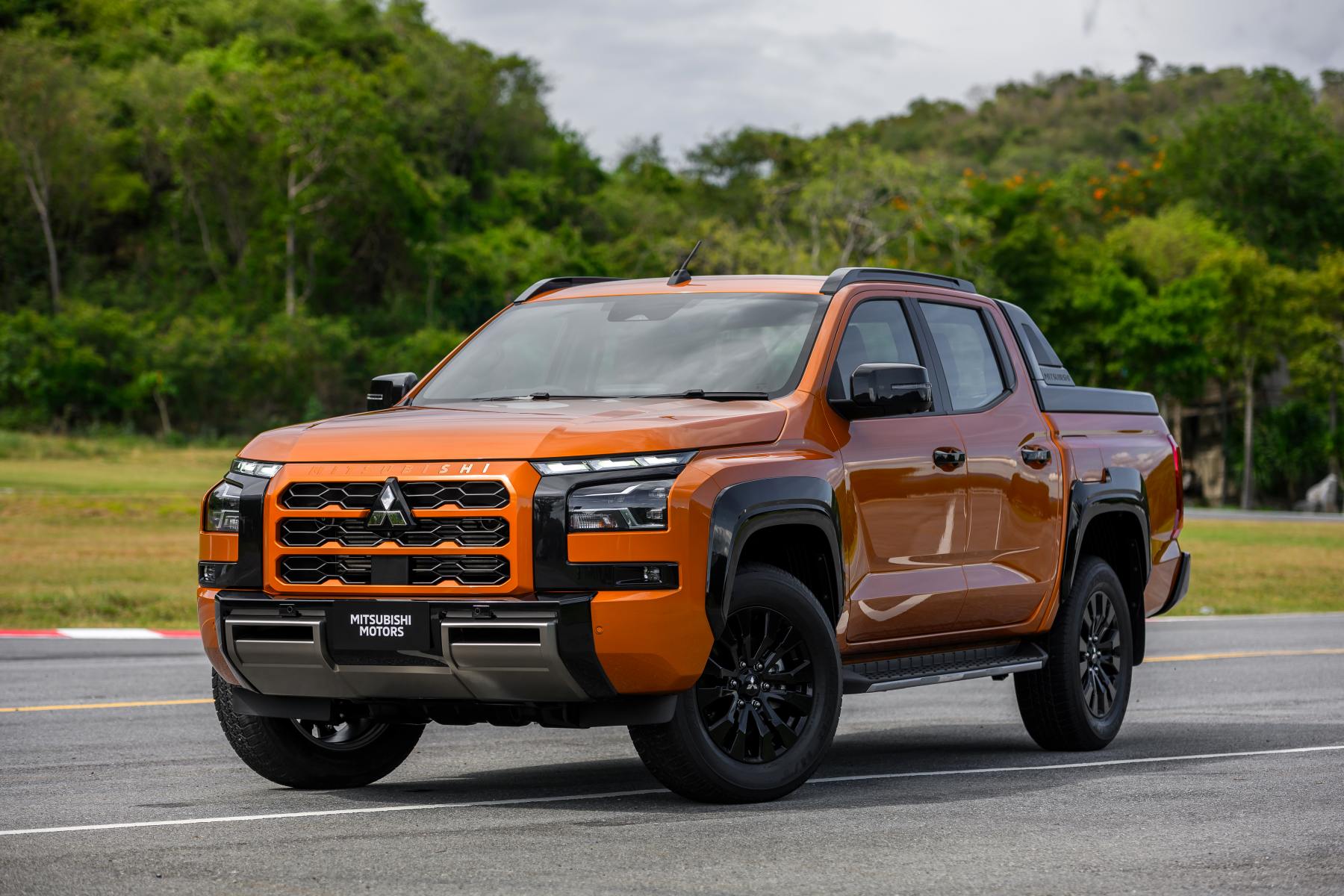
- Significantly enhanced new-gen Triton due in Australian showrooms in February, 2024
- New-gen Triton introduces Bi-Turbo diesel engine with 150kW and 470Nm
- Impressive safety suite offered range-wide, including class-first Driver Monitoring System as well as rear AEB, Forward Collision Mitigation with pedestrian detection, cyclist detection and junction assist. A centre airbag makes its Triton debut.
- Substantial redesign brings increased road presence, capability and comfort
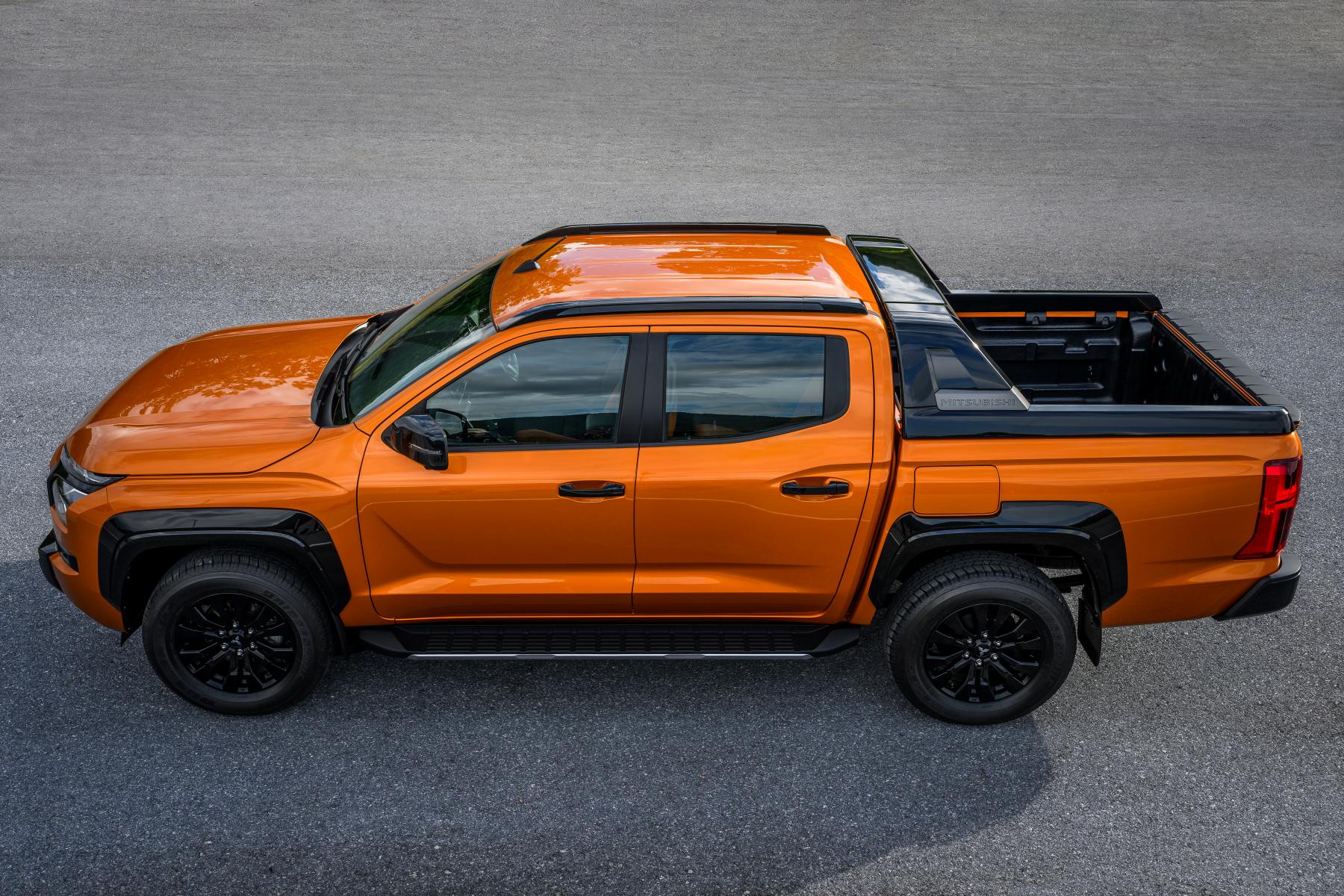
“New-gen Triton is such a significant vehicle for Mitsubishi, globally and of course in Australia,” said MMAL CEO, Shaun Westcott.
“The new model is a significant step forward in many ways, with its upgraded drivetrain, enhanced load carrying capacity, increased interior comfort and modern day connectivity options.
“But it also retains the trademark Triton toughness, with a global vehicle development program that included Australia.
“New Triton retains incredible off-road capability, but is equally at home on the work site, the desert, the beach, the snow or in the city. We cannot wait to bring the Triton to Australian showrooms,” he said.
Australian-market production of the new-gen Triton will commence in Thailand in December, 2023 with expected showroom arrivals in February, 2024.
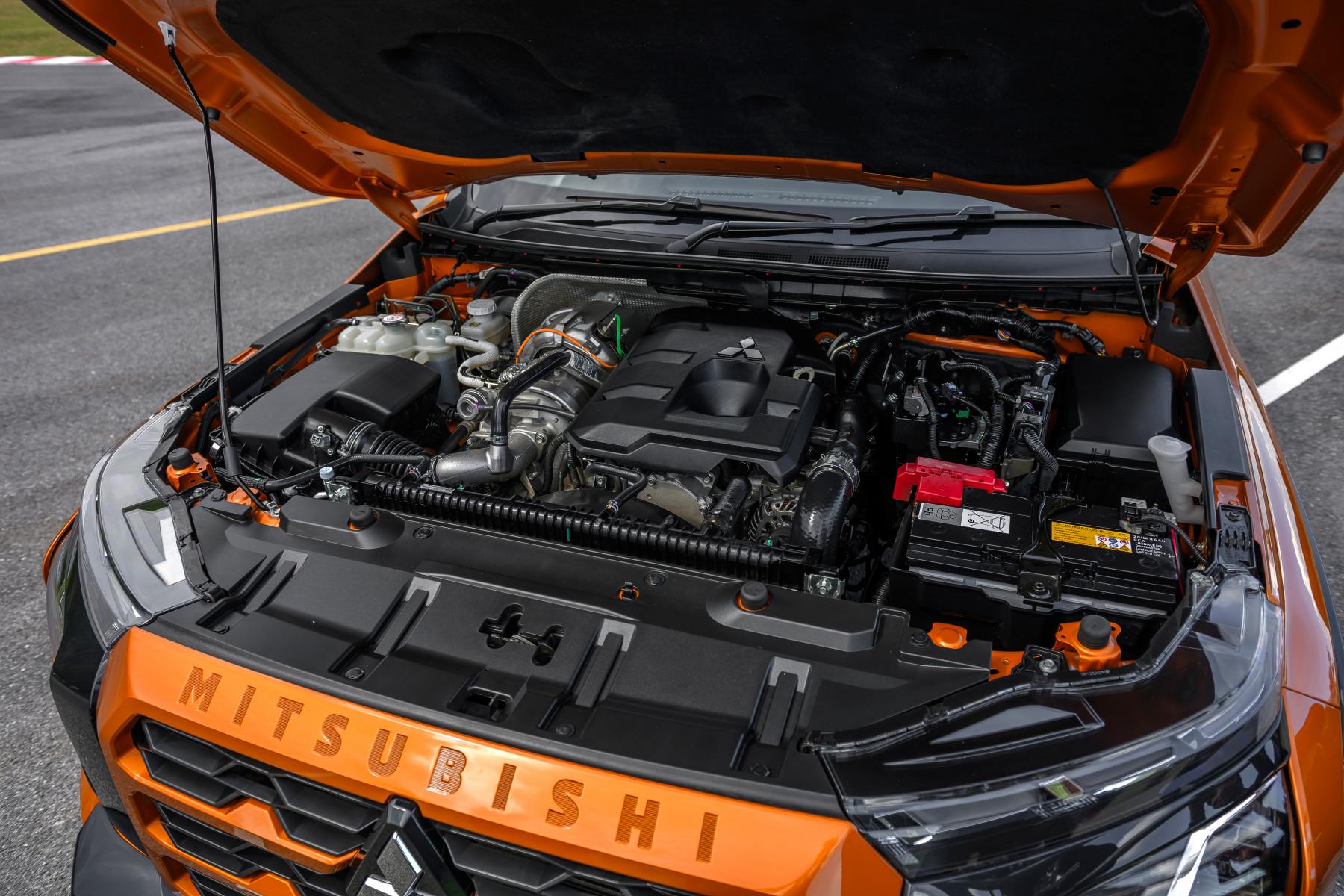
New Bi-Turbo drivetrain boosts power and torque
New-gen Triton boasts a significantly enhanced, Mitsubishi-designed and developed 2.4-litre Bi-Turbo diesel engine. This power unit employs ‘twin stage’ turbocharging – two turbochargers, one small for fast response at low revs, and a larger turbo to fortify the top end – to develop 150kW of power with a 470Nm peak torque figure.
Both 4 x 2 and 4 x 4 drivetrains will be available with an updated six-automatic transmission. A six-speed manual will also be offered on some variants post-launch.
Fuel consumption and additional drivetrain details will be provided closer to the Australian launch date.
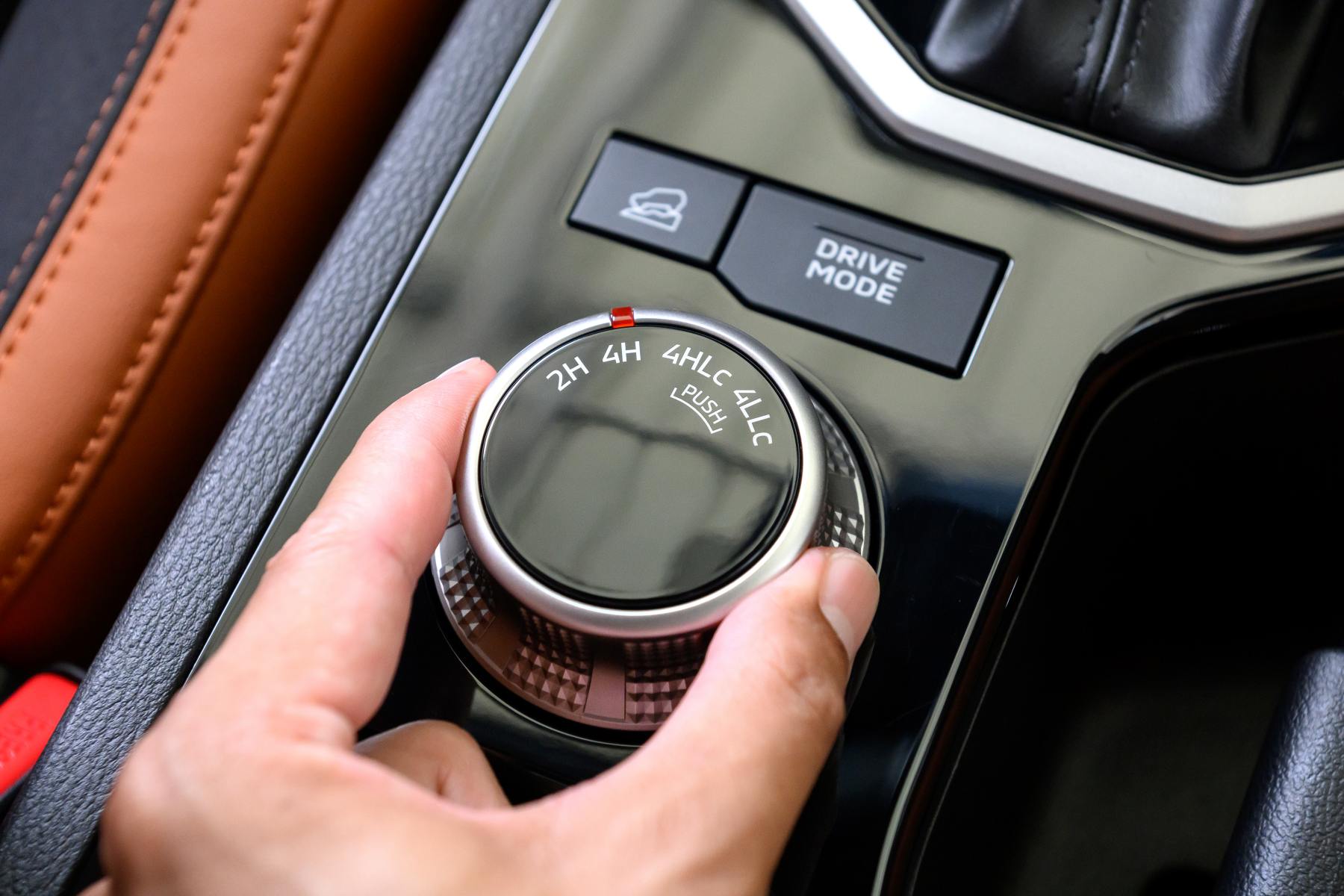
Launch model range: Something for everybody
New-gen Triton follows the Triton tradition, with a wide range of model grades designed to cater to every need.
At launch, Double Cab and Club Cab Pickup variants will be available, with Cab-Chassis variants to be added post-launch.
New-gen Triton follows a highly recognisable model structure, offering GLX, GLX+, GLS and GSR grades.
GLX and GLX+ feature the user-friendly Easy Select 4WD system, with GLX+ models also gaining standard rear differential lock.
GLS and GSR will utilise Mitsubishi’s renowned Super Select 4WD II system, allowing the driver to select 4WD high-range without locking the centre differential, for additional traction on paved surfaces.
An updated drive mode system adds an Eco mode, and separates Mud and Snow modes for more specific control.
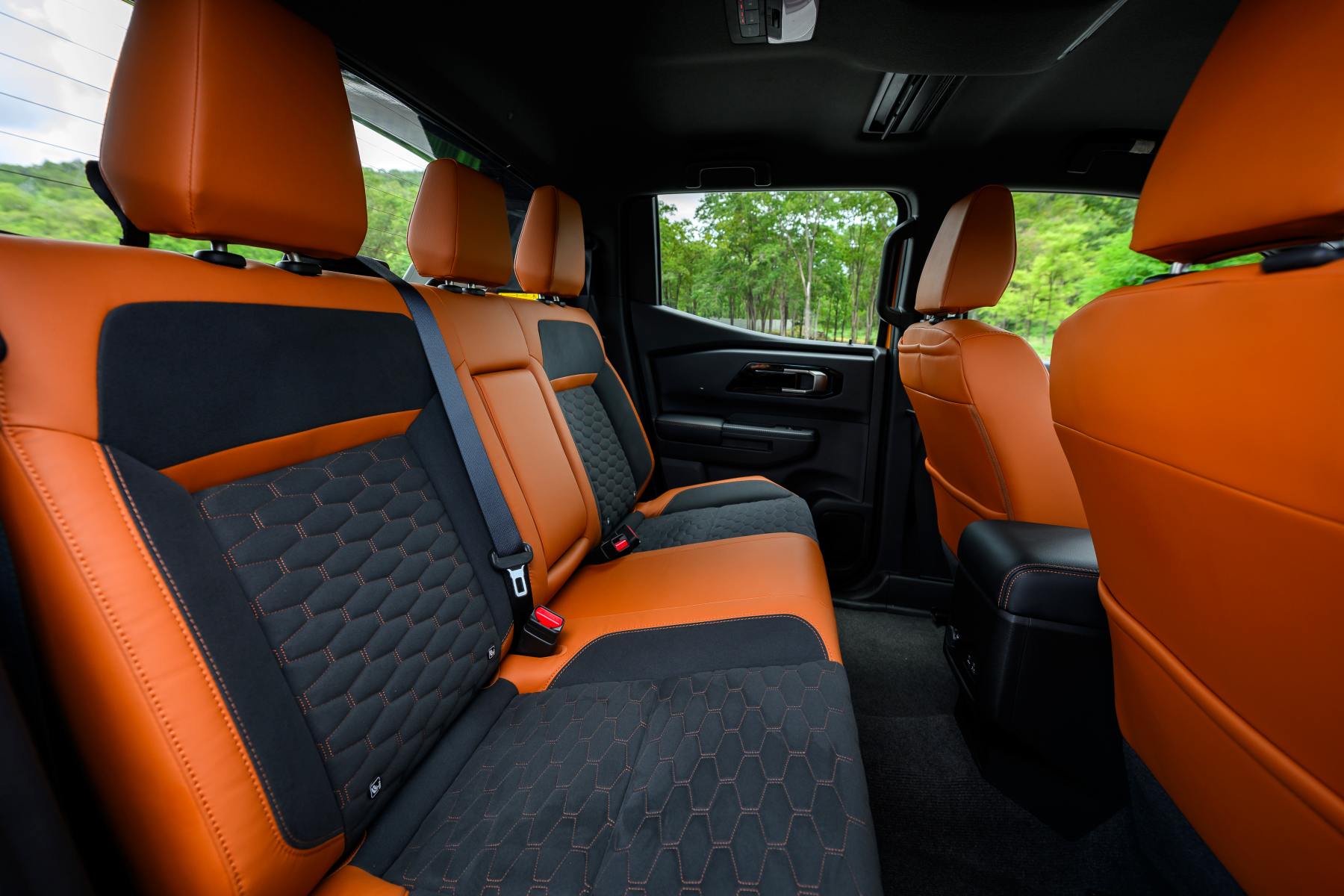
New-gen Triton: Grades available from launch
| Drivetrain | Grade | Engine | Transmission | Body |
| 4 x 2 | GLX | 2.4L Bi-Turbo Diesel | 6AT | Double Cab – Pick Up |
| 4 x 4 | GLX+ | 2.4L Bi-Turbo Diesel | 6AT | Club Cab – Pick Up |
| 4 x 4 | GLX | 2.4L Bi-Turbo Diesel | 6AT | Double Cab – Pick Up |
| 4 x 4 | GLS | 2.4L Bi-Turbo Diesel | 6AT | Double Cab – Pick Up |
| 4 x 4 | GSR | 2.4L Bi-Turbo Diesel | 6AT | Double Cab – Pick Up |
Also continuing is the popular GLS with Leather interior option. This will be available to order on GLS Dual Cab Pickups from launch.
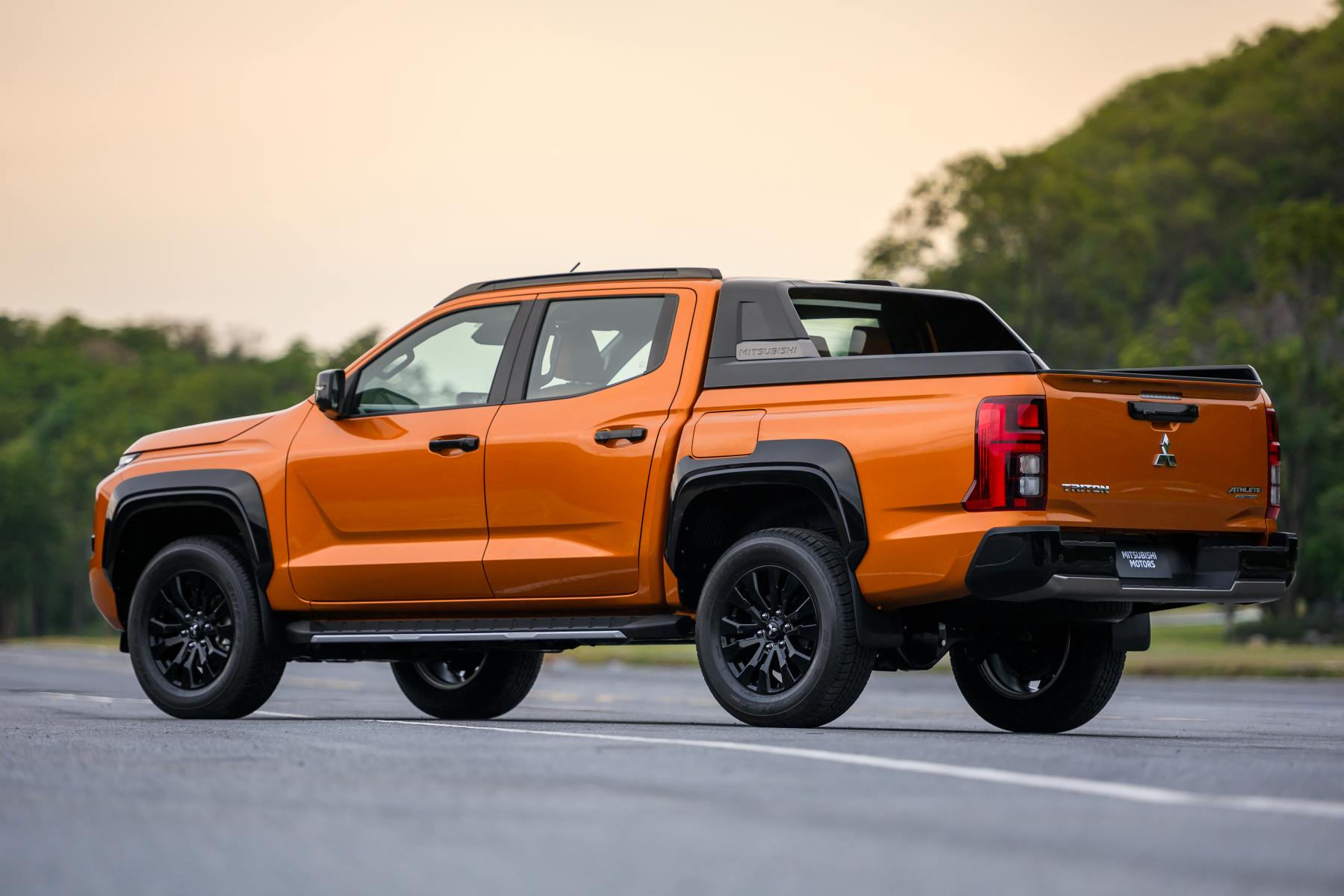
Striking new design
The new-gen Triton has been redesigned inside and out, creating a commanding presence with improved materials throughout. The new body also reduces drag by 8.1 per cent for enhanced aerodynamics.
This impressive road presence is underpinned by Mitsubishi Motor’s latest frame platform, an all-new design.
With a striking face and wider stance, the new-gen Triton’s exterior is complemented by a range of new-design alloy wheels. The interior elevates occupant space and comfort with higher quality finishes and the added convenience of multiple storage spaces including bottle, drink and sunglass holders.
Two exciting colours also debut: Blade Silver and the GSR-only Yamabuki Orange.
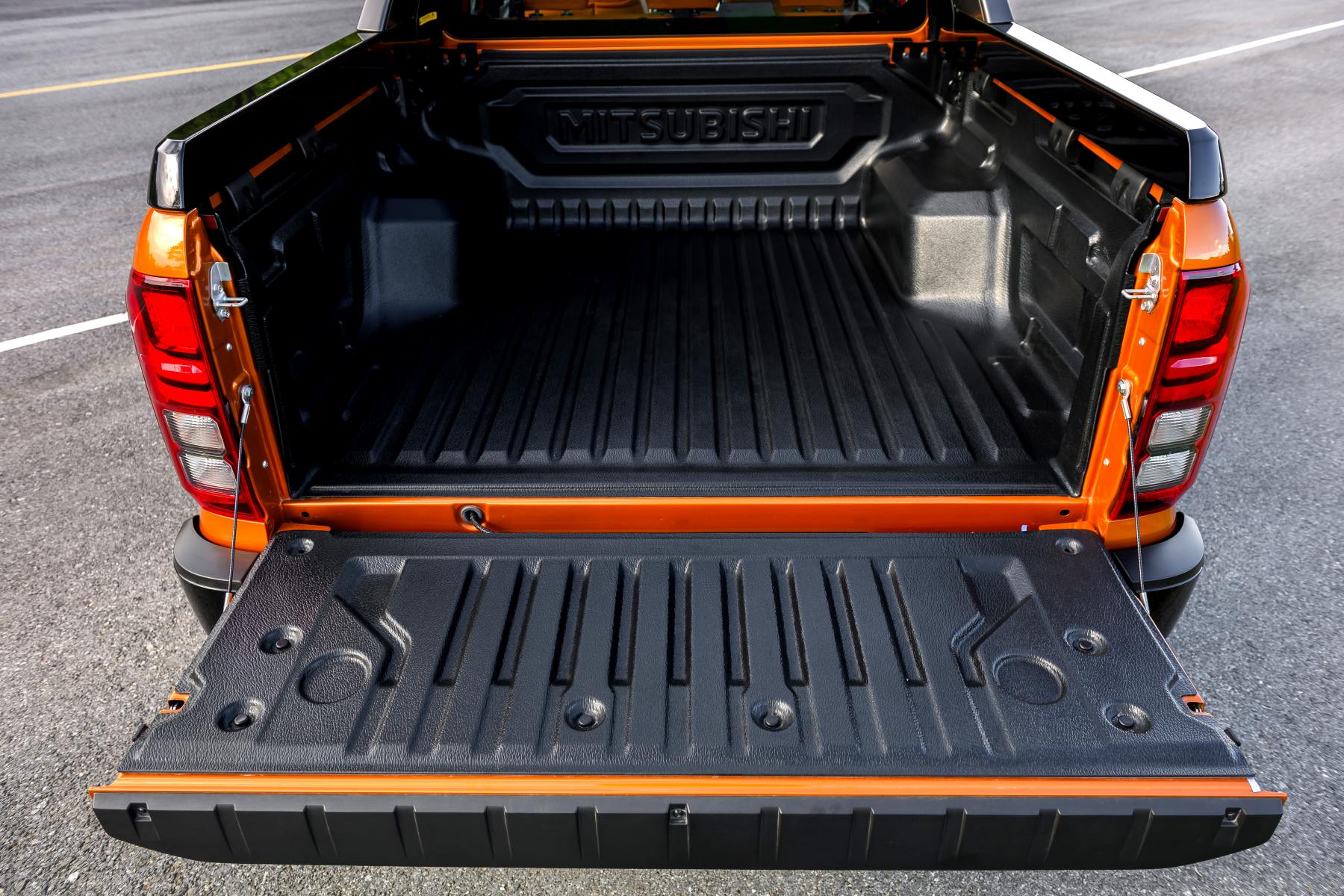
Dimension essentials
New-gen Triton is also larger in both length and width, further enhancing cabin space and load capacity.
A 3,500kg braked tow rating, up some 400kg from the previous-generation, further extends new-gen Triton’s multi-purpose repertoire.
| Dimension (Dual Cab models) | Measure (change) |
| Body length | 5,320mm (+15mm) |
| Body width | 1,865mm (+50mm) |
| Wheelbase | 3,130mm (+130mm) |
| Tray length | 1,555mm (+35mm) |
| Interior shoulder room | 1,479mm (+49mm) |
| Hip point couple | 780mm (+40mm) |
| Towing capacity | 3,500kg (+400kg) |
Setting the safety standard
Mitsubishi’s commitment to safety has been further refined with new-gen Triton.
Headlining the comprehensive safety suite is a class-first Driver Monitoring System, while rear AEB, Forward Collision Mitigation with pedestrian detection, cyclist detection and junction assist add further to new-gen Triton’s safety credentials.
Other key active safety systems such as Active Yaw Control, Adaptive Cruise Control (AT models), front and rear cross traffic alerts, blind spot warning and intervention, and lane departure warning and prevention are also available.
For the first time in Triton, a centre airbag is also included.
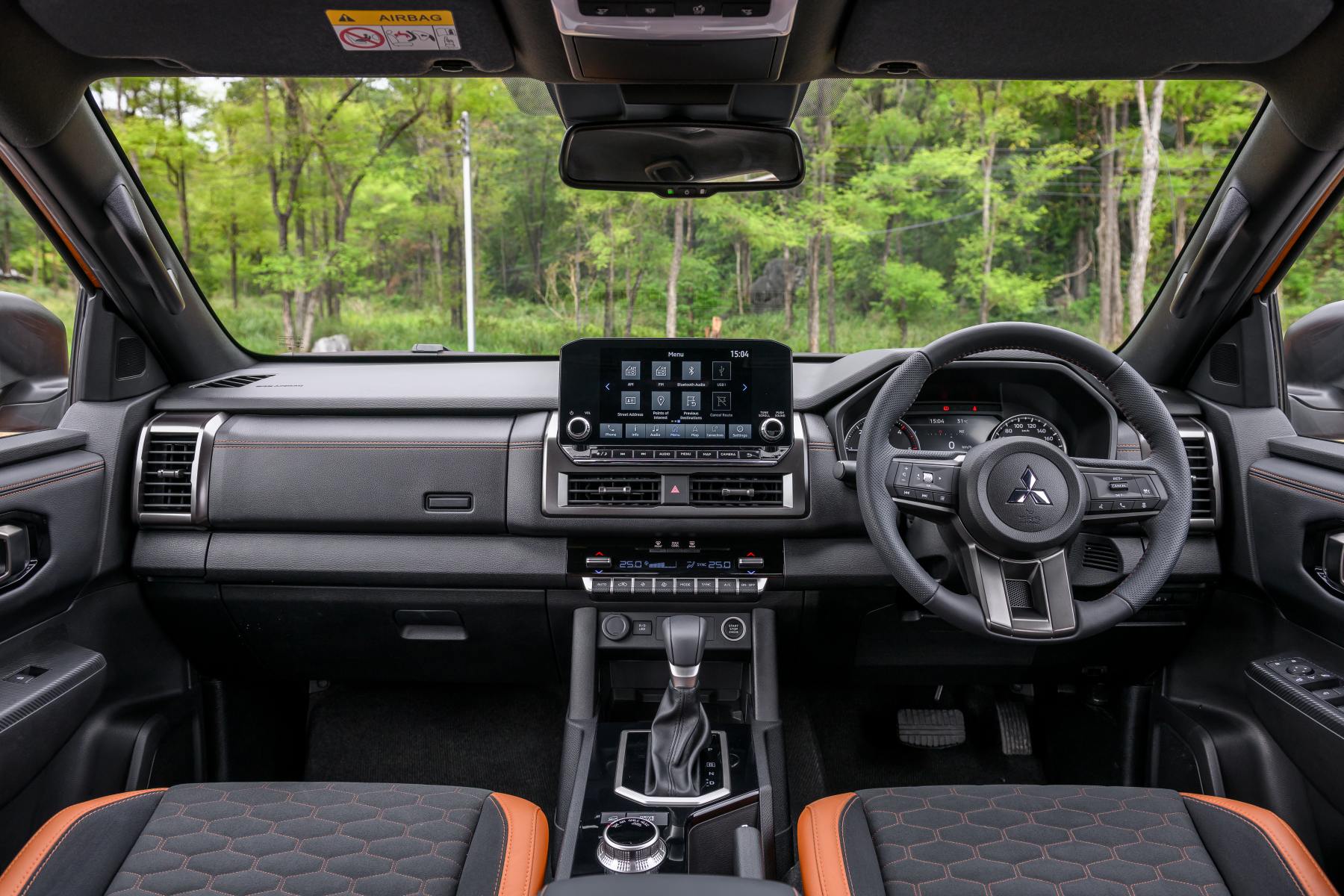
Sophisticated systems that keep you connected
A new 9.0-inch audio display will be offered as standard throughout the range, with a 7.0-inch LCD ‘Meter Cluster’ and integrated satellite navigation including traffic sign recognition further supporting the driver.
Wireless Apple CarPlay as well as Bluetooth connectivity with voice and steering wheel-mounted controls make interaction a breeze.
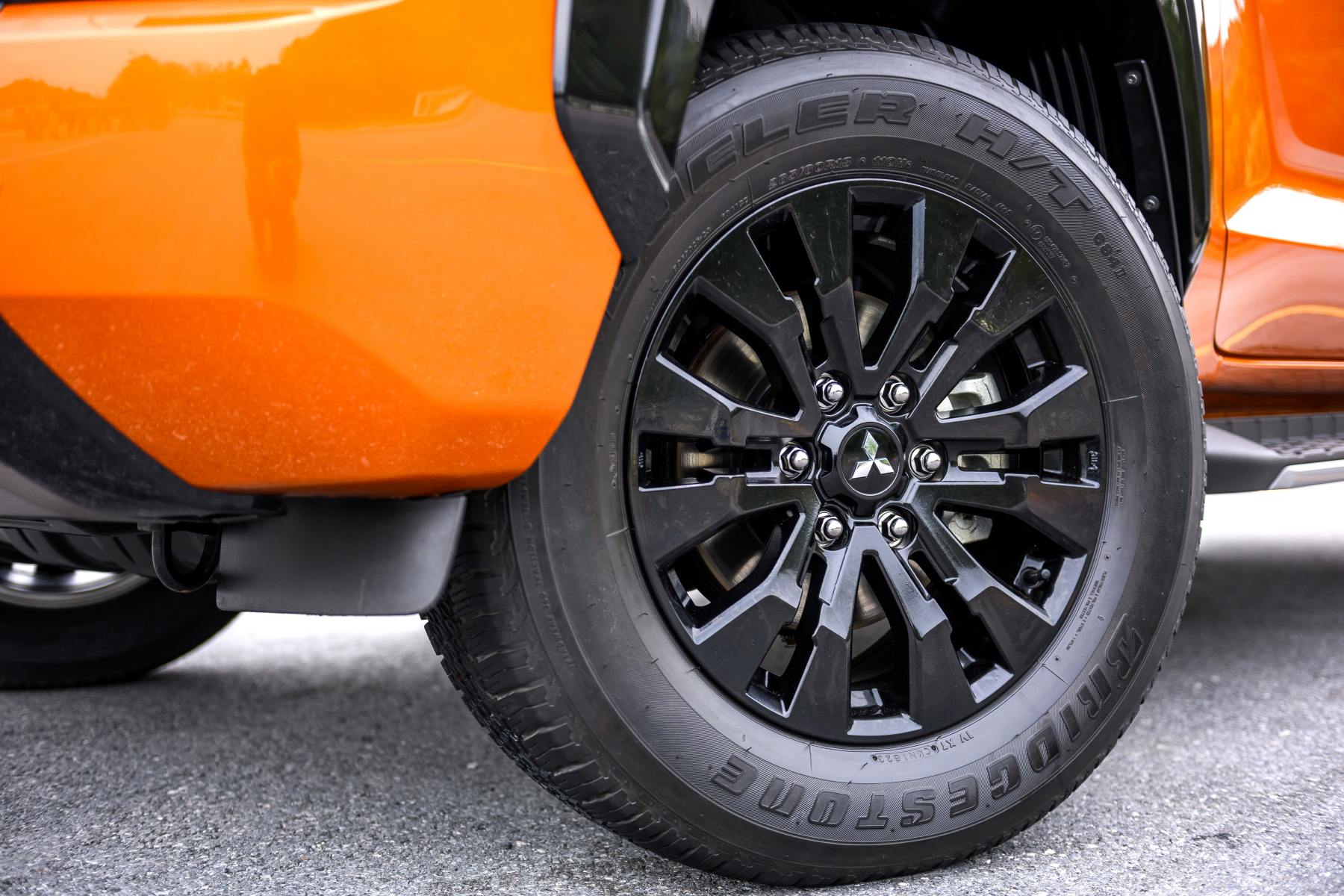
Gain a Diamond Advantage with Australia’s only 10/10 warranty and capped price servicing program*
Australia’s only 10/10 Diamond Advantage offering will continue for new-gen Triton. New Triton owners are ensured peace-of-mind with a 10-year warranty and 10-year capped price servicing program.
Coming to Australia in February 2024
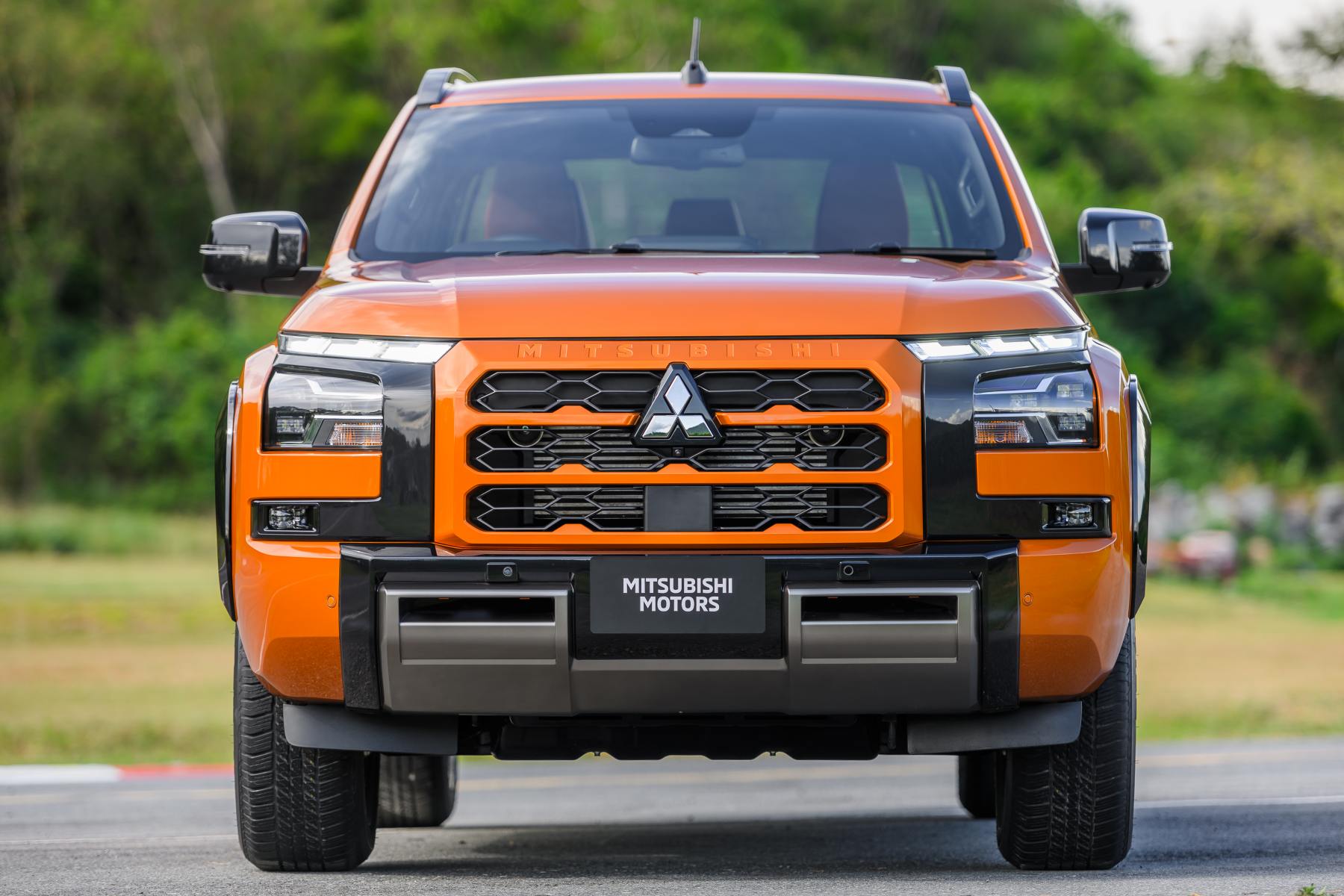
World Premiere Mitsubishi Triton (26 July)
- Sales Starts in Thailand Today, Launch Planned for Japan in Early 2024
Mitsubishi Motors Corporation (hereafter, Mitsubishi Motors) premiered the fully redesigned Triton¹ one-ton pickup truck in Bangkok, Thailand, with sales commencing today in Thailand. The all-new Triton will be rolled out in markets centering on the ASEAN and Oceania regions and is scheduled for launch in Japan in early 2024 for the first time in 12 years.
Special website for the all-new Triton:
https://www.mitsubishi-motors.com/en/products/triton
Mitsubishi Motors has produced approximately 5.6 million pickup trucks spanning five generations over the 45 years since its first launch in 1978. With a record of sales in 150 countries, the pickup truck is a global strategic vehicle for Mitsubishi Motors. Now in its sixth generation, the all-new Triton is fully redesigned for the first time in nine years. Based on the product concept “Power for Adventure,” all elements of the Triton have been completely reimagined, from the interior and exterior design to the chassis, ladder frame and engine.
The key features of the all-new Triton are as described below:
- A beefed-up body size compared to the previous model, a newly developed ladder frame that provides durability and reliability, and a newly developed engine that achieves both higher output and improved environmental performance
- A newly developed suspension that provides excellent ride comfort and steering stability, and Super Select 4WD-II system and upgraded drive modes that achieve high road performance
- A front face with a strong sense of presence and reliability, a wide and robust styling, and a classy interior offering excellent functionality and operability
- Significantly improved safety and comfort for a wide range of purposes, from business to personal use
“As a pickup truck that fits for a new era, we have developed the all-new Triton with even more Mitsubishi Motors-ness,” said Takao Kato, president and chief executive officer, Mitsubishi Motors. “The key features of the all-new Triton were exclusively developed by Mitsubishi Motors, including a robust ladder frame and body, tough chassis, powerful and driver-friendly engine and 4WD system that achieves excellent road handling and stability. With production ultimately expected to reach 200,000 vehicles in over 100 countries, the all-new Triton is an extremely important model that will provide foundational support for Mitsubishi Motors, as well as the first global strategic vehicle to be rolled out at the start of our growth phase. Please look forward to our challenges that begin from here.”
Product Overview
The all-new Triton comes in three body types depending on the intended use – a double-cab type with two rows of seats offering both the comfort of an SUV and the utility of a pickup truck, a basic single-cab type with one row of seats, and a club-cab type with cargo space behind the front seats that also enables reclining. With a larger body, it has a newly developed 2.4L clean diesel turbo engine that significantly boosts environmental performance and power.
The ladder frame, suspension and other main components have been newly developed uniquely by Mitsubishi Motors, and road performance has been greatly enhanced through features such as upgraded drive mode and electronically controlled Active Yaw Control (AYC) combined with Super Select 4WD-II system. With the adoption of Adaptive Cruise Control (ACC) among other new safety features and emergency support using connected car technology, safety and comfort has been greatly improved not only in terms of the truck’s hardware, but also in terms of its software.
(1) Tough ladder frame and high-efficiency clean diesel engine
The newly developed ladder frame has a 65% greater cross-sectional area than the previous model, achieving a bending rigidity increase of 60% and a torsional rigidity increase of 40%. Furthermore, weight increase has been minimized by increasing the ratio of high-tensile steel used. As well as offering significantly better road performance and ride comfort, the all-new Triton also boasts increased robustness by improving durability during loading and energy dispersion in the event of a collision.
The body is also lighter than the previous model through the use of a new 1180 MPa high-tensile steel material.
The newly developed 4N16 clean diesel engine comes in three different output specifications to meet different purposes. The high-output version is equipped with a new turbo charger and new combustion system, providing a flat maximum output of 150 kW and maximum torque of 470 Nm from approximately 1,500 rpm, enabling highly-responsive driving with abundant torque in the range of practical use. There are two versions of the standard specification – one with an engine that has a maximum output of 135 kW and a maximum torque of 430 Nm, and one with an engine that has a maximum output of 110 kW and a maximum torque of 330 Nm. Both have a variable geometry turbo charger that performs variable control of turbine capacity.
The all-new Triton comes with either a six-speed automatic transmission with the highly acclaimed Sports mode from the previous model, or a six-speed manual transmission with shift-by-wire that reduces vibration directly transmitted from the engine and improving comfort.
(2) Improved road performance by newly developed suspension and a mature 4WD system
The 4WD system enables the driver to easily shift to 4WD mode while driving by using a dial selector. The all-new Triton continues to use Mitsubishi Motors’ Super Select 4WD-II and Easy Select 4WD systems, and Super Select 4WD-II is equipped with a centre torque sensing Limited Slip Differential (LSD) that distributes driving force at a ratio of 40% to the front and 60% to the rear, thus ensuring both traction performance and cornering performance.
Models equipped with the Super Select 4WD-II system can select from the four options of 2H (rear-wheel drive), 4H (full-time four-wheel drive), 4HLc (locked centre differential) and 4LLc (locked centre differential with lower gears), and have seven drive modes including on-road modes, an increase over the four off-road modes of the previous model. Along with Normal mode that is available in all four-wheel drive modes, 2H offers Eco mode for prioritization of economy, 4H offers Gravel and Snow modes, 4HLc offers Mud and Sand modes for traction performance, while 4LLc provides Rock mode, allowing drivers to select the optimum drive mode for any road condition. The 4WD modes available for selection in vehicles equipped with Easy Select 4WD are 2H (rear-wheel drive), 4H (locked centre differential), and 4L (for low-gear driving).
Active Yaw Control
AYC is newly adopted for models equipped with the Super Select 4WD-II system. It improves cornering performance by applying light braking to the inside front wheel when cornering. Both the two-wheel and four-wheel drive models are equipped with active LSD (brake control type). By applying the brake to a spinning wheel and distributing the driving torque to wheels gripping the road surface, it improves safety on slippery surfaces while also providing a sporty driving experience.
Active Stability & Traction Control
Active Stability & Traction Control (ASTC) that improves stability on winding roads is standard equipped on all models. Other systems include Hill Descent Control (HDC), which maintains a set speed on downhill slopes to enable driving with confidence, and Hill Start Assist (HSA), which prevents roll-back in hill starts.
The newly developed suspension retains a double wishbone structure for the front suspension, and prioritizes reliability and durability. The upper suspension mounting arm has been moved higher to increase the stroke by 20mm, providing improved road-holding and ride comfort. The rear suspension provides greater ride comfort while retaining its strength and uses a lighter leaf spring system together with thicker shock absorbers.
While beefing-up the body size, the increase in turning radius has been minimized, and driving has been made easier by using a hood shape that lets the driver see the hood line. For the high-output engine model, an electric power steering is adopted, which enables better control by providing more assistance in the low-speed range, while it increases feedback in the high-speed range to provide peace of mind for the driver. It also takes safety and comfort into account through its reduction of kickback from the road surface and tuning for off-road driving or towing.
(3) Beast Mode design concept
The all-new Triton combines agility with the Mitsubishi Motors’ robust design to create an imposing look while expressing the toughness and powerfulness expected of a pickup truck.
The front face design concept of Dynamic Shield that expresses powerful performance and the peace of mind protecting both the people and the car is optimized for a pickup truck through a powerful form based on a robust, three-dimensional front grille and fenders, and a protector that emphasizes this form. The daytime running lights featuring three L-shaped LED lights resemble a sharp gaze of a hawk, and in combination with the three-dimensional 3-light headlights below them, the design gives the all-new Triton an overwhelming presence.
The horizontally-themed body sides are composed of large, solid surfaces that emphasize the robust doors, while contrasting with the sharply overhanging fender panels to tighten them and make them appear wider, emphasizing stability and toughness.
While ensuring the cargo bed is of an ample size, the solid surfaces continue along the side of the body up to the rear end. T-shaped tail lights on both sides emphasize width while also robustly displaying the sturdy rear design.
Functional design has been incorporated in all aspects to drastically increase utility, including a cabin shape and rear spoiler that improve aerodynamics, more durable door handles that are now bigger and easier to grip, and wider side steps with improved water drainage.
Instrument panel is designed with the Horizontal Axis concept,
The instrument panel is designed with the Horizontal Axis concept, which uses horizontally-themed and strong shapes to allow drivers to easily see changes in the posture of the vehicle when driving. With a nod to professional use, soft pads have been incorporated in the main areas that protect passengers to ensure utility. In terms of design, the interior uses many geometric shapes and metallic elements to create a high-contrast, modern space.
Particular attention has been paid to visibility for the monitor, meters, and switches that make use of contrast, and the selectors, dials, and switches all have the optimum level of sensitivity to allow them to be operated while wearing gloves. The steering wheel, grips, and door handles have all been designed based on an approach called Mitsubishi Touch, with a focus on grip comfort and sturdiness.
Centre Console
The 6A/T and 6M/T centre console has a cup holder that can accommodate two large cups, and the console box can hold four 600 mL plastic bottles. Taking professional use into account, the console box in the 5A/T model is capable of holding tablets and files in addition to being a cup holder. The glove box, smartphone holder, and other storage for small items are of an ample size that enables easy use even when wearing gloves, and the instrument panel and centre console have USB A and C sockets for charging devices, as well as a wireless charger at the bottom of the centre part of the instrument panel.
Newly rolled out body colors are the vivid and metallic Yamabuki Orange Metallic and the Blade Silver Metallic that offers increased brilliance. The lineup also includes the high-quality basic colours – White Diamond, Solid White, Graphite Gray Metallic, and Jet Black Mica.
With the highest trim level, the front grill is the same colour as the body, while the door mirrors, Dynamic Shield garnish, plated components including the door handles, bumper, and other parts are black, and the underside of the front, sides, and rear is dark titanium. A styling bar on the black roof rails, over fenders, and cargo bed brings a sharper look. The use of black as the base colour for the metallic embellishments in the interior brings sleekness, while orange accents bring a sense of class and sharpness.
(4) Improved basic performance as a pickup truck
The cargo bed height has been lowered by 45 mm to 820 mm compared to the previous model, and the upper surface area of the bumper corner has been enlarged and reinforced with a frame to be used as a foot space, thereby improving practicality.
The front seats provide firm lower back support while the shoulder areas provide ease of movement with an open shape, which helps to reduce driver fatigue. The hip point has also been moved 20 mm up compared to the previous model and an upright posture has been adopted to improve visibility from inside the vehicle. In addition, ingress and egress have been made easier by designing the A-pillar to be more vertical to widen the door openings and widening the side steps while making them a shape that reduces the risk of slipping.
The all-new Triton now comes equipped with Adaptive Cruise Control (ACC) that tracks acceleration, deceleration, and stopping of the vehicle in front, and cruises while maintaining a preset distance between vehicles. Advanced safety features have been enhanced along with the retention of Forward Collision Mitigation system (FCM), Blind Spot Warning (BSW) with Lane Change Assist (LCA), and Rear Cross Traffic Alert (RCTA) among others.
Mitsubishi Connect
Mitsubishi Connect makes the experience of owning and driving a car more comfortable and enjoyable. For driver safety, a request for help can be made to a call centre with the touch of a single button in the event of an accident or breakdown, while also being capable of automatically reporting the deployment of an airbag.
By linking with a smartphone, Mitsubishi Connect enables a car finder function that displays the location of a parked car. Users can also check the remaining fuel volume and oil state, drive history, and other aspects of the vehicle’s state. Furthermore, remote operations let users switch on the air conditioning before they get in the car, and also operate the headlights and horn. Smartphone linking uses the cellular network, so users can receive information from their car even if they are far away, provided they are in an area with cellular coverage.
To Improve maintainability, the location of the drain bolt has been changed to enable engine oil to be replaced without having to remove and replace the under-cover, and for 4WD/2WD High Riders, service hole size has been increased to enable garage jacks to be used without an attachment. And with gear oil replacement being unnecessary in the six-speed manual transmission model among other improvements, maintenance is becoming increasingly unneeded.
A wide range of accessories are available, from protectors to dress-up accessories. The sport bar, fender arch moldings, and side door garnishes emphasize the solid image, and the grille emblems tighten the look. A bed liner, which is indispensable for pickup trucks, is also available.
Drivetrain2
1. Sold as L200 in some markets
2. Combination of powertrain may vary by market.
All new Triton – All new chassis (10 July 2023)
Mitsubishi Motors Corporation (hereafter, Mitsubishi Motors) will use a newly developed ladder frame, chassis and clean diesel engine in the all-new Triton1 one-ton pickup truck to achieve safe, secure and comfortable driving for any weather or road conditions. A video of the all-new Triton undergoing development including road testing is released on a special website.
The launch of the all-new Triton, scheduled for Wednesday, July 26, at 10am local time in Bangkok, Thailand (12pm JST), will be livestreamed on the special website.
Special website for the all-new Triton:
https://www.mitsubishi-motors.com/en/products/triton
Team Mitsubishi Ralliart announces team lineup for Asia Cross Country Rally 2023 (30 June 2023)
Mitsubishi Motors Corporation (hereafter, Mitsubishi Motors) announced that Team Mitsubishi Ralliart, for which the company provides technical support, will be competing in the Asia Cross Country Rally (AXCR) scheduled for August of this year. As with last year, Mitsubishi Motors’ Hiroshi Masuoka will serve as team director, Chayapon Yotha (Thailand) the champion driver of AXCR 2022 and Rifat Sungkar (Indonesia) will be returning again this year, joined by new Japanese driver Katsuhiko Taguchi.
AXCR2023 Special website:
https://www.mitsubishi-motors.com/en/innovation/motorsports/axcr2023/
Team Mitsubishi Ralliart claimed an overall victory last year in its first attempt at AXCR. This year, the following team drivers and co-drivers will attempt to claim a second consecutive win: defending champions Chayapon Yotha (Thailand) and Peerapong Sombutwong (Thailand), last year’s 5th place drivers Rifat Sungkar (Indonesia) and Chupong Chaiwan (Thailand), and Japanese duo Katsuhiko Taguchi and Takahiro Yasui.
They will be driving a total of three new Triton Group T1s (prototype cross-country vehicles). Team Mitsubishi Ralliart will have all the resources it needs to take on the AXCR challenge; TANT SPORT (Thailand), which owns the team, is joined by team director Hiroshi Masuoka, a former two-time consecutive Dakar Rally champion driver, and Mitsubishi Motors engineers will accompany the team to provide technical support.
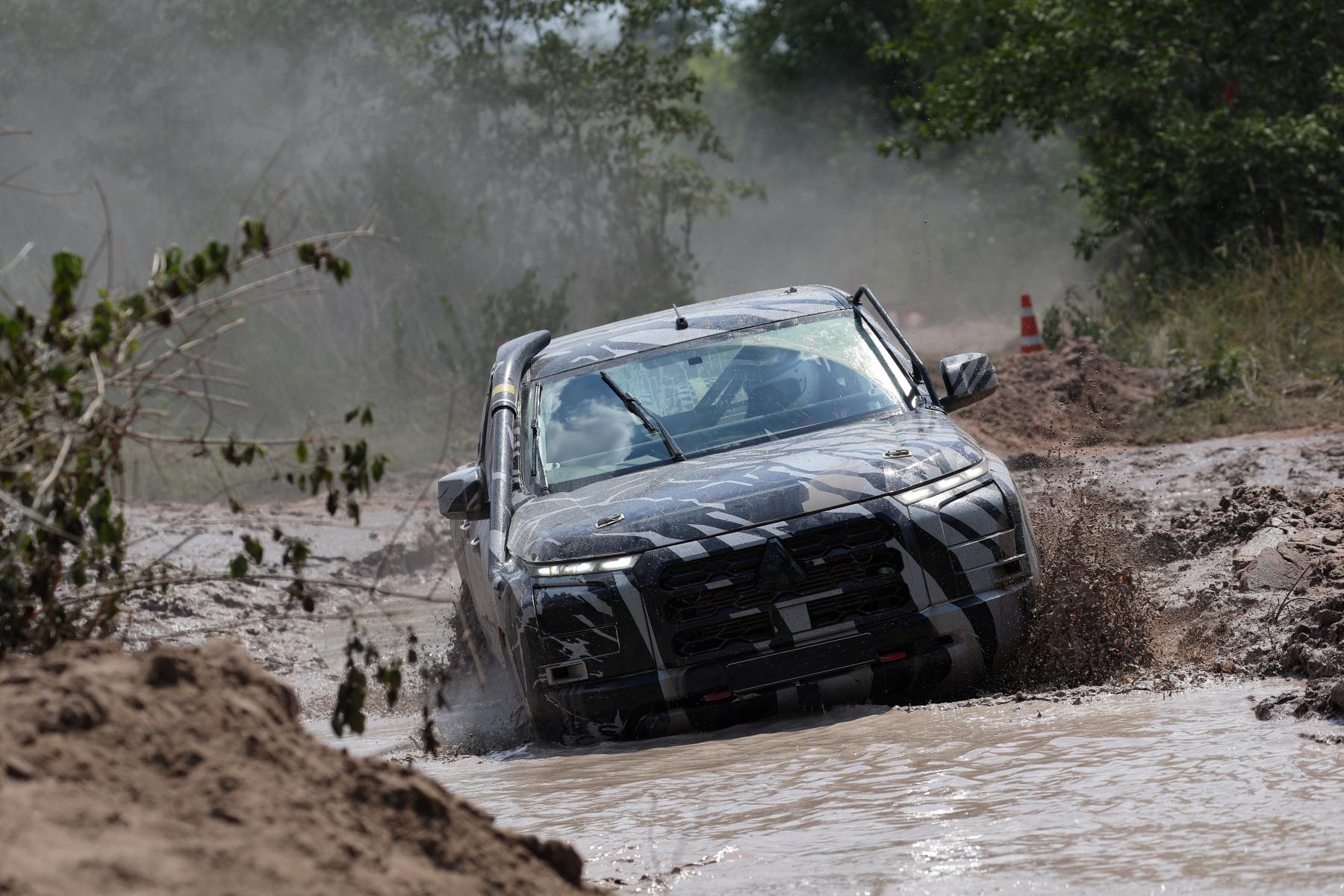
Team Mitsubishi Ralliart
From June 19 to June 23, Team Mitsubishi Ralliart conducted rigorous endurance tests of the Triton rally cars, envisioning actual rally conditions, on an off-road course near Khao Yai National Park, in the heart of Thailand. The all-new Triton rally car has been completely redesigned, including its body, frame, chassis, and engine, greatly increasing its competitive potential. The reliability and durability of the rally cars, primarily their bodies and engines, were confirmed by driving roughly 800km over the course of the five days endurance test, and adjustments were made in preparation for the actual competition.
“Based on the original strength of the all-new Triton, the handling performance, stability on rough roads, and ride comfort are further improved as a rally competition car. In addition, the turbocharger has been improved to increase engine response throughout the entire rally range from low to high rpm, resulting in a powerful rally car that can handle any road conditions.” said Hiroshi Masuoka, team director of Team Mitsubishi Ralliart. “We have conducted the endurance test with a harder course setting than the actual rally conditions, but the testing cars were able to drive through about 800 km each without any major initial troubles, confirming performance beyond our expectations and giving us a great confidence for our second consecutive championship.”
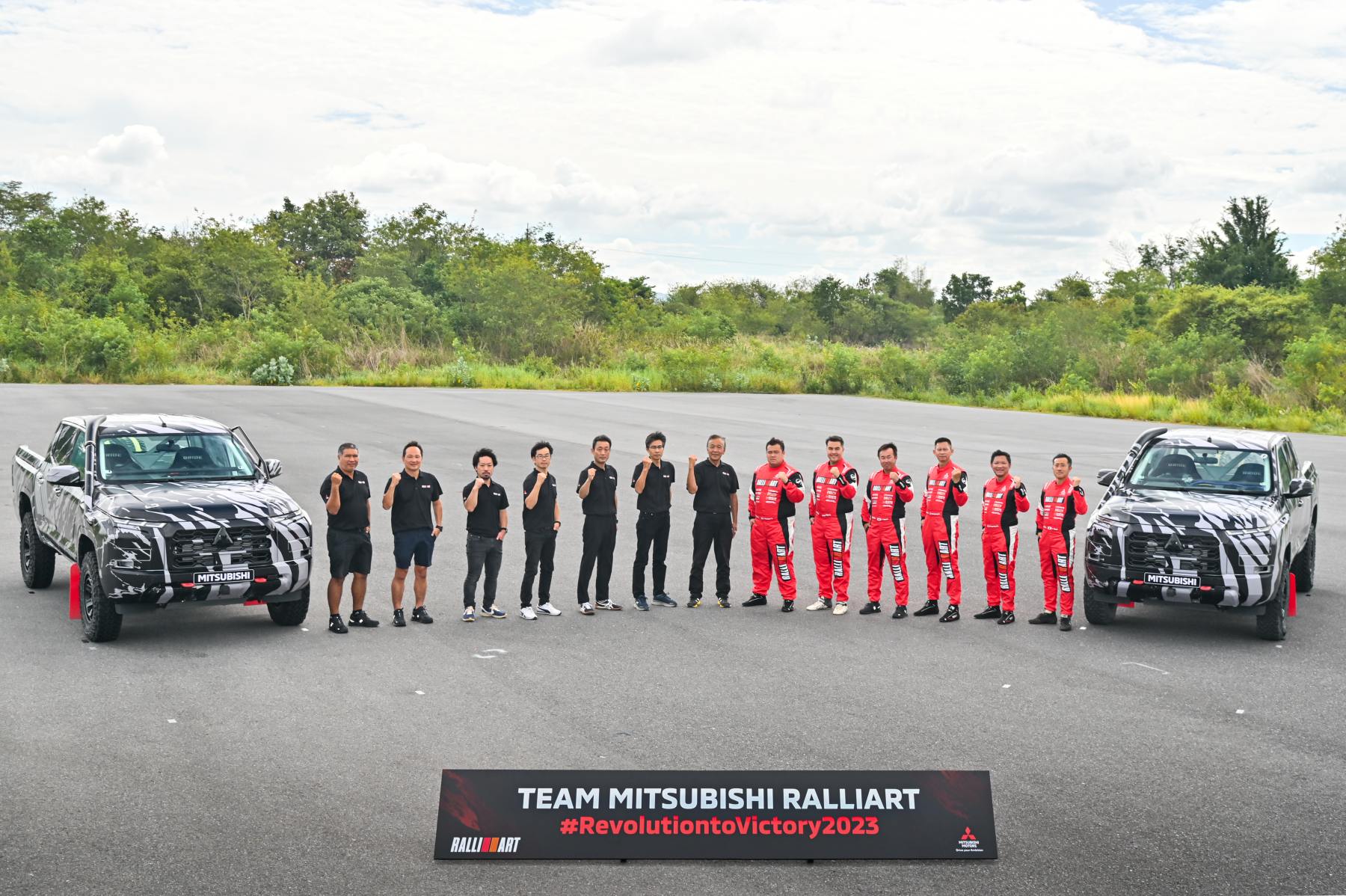
1. Profile of Team Mitsubishi RALLIART
Team Director: Hiroshi Masuoka (Mitsubishi Motors)
Team Principal: Chayut Yangpichit (Thailand: TANT SPORT)
Technical Director: Kopong Amatayakul (Thailand: TANT SPORT)
Technical Support (body, chassis): Noriyoshi Aiba (Mitsubishi Motors)
(engine): Takashi Shibayama (Mitsubishi Motors)
Drivers and co-drivers:
Chayapon Yotha
From: Udon Thani Province, Thailand
Born: August 16, 1987 (35)
Career: Champion driver of AXCR 2022, who led Team Mitsubishi Ralliart to overall victory in its first time competing in AXCR with his careful and precise driving. He has won numerous races since 2012, including the Thailand Super Series, and RAAT Thailand Endurance Championship International. In 2019, he took victories in the Thailand Super Series’ Supercar GTC.
Co-driver: Peerapong Sombutwong (Thailand)
Rifat Sungkar
From: Jakarta, Indonesia
Born: October 22, 1978 (44)
Career: One of Indonesia’s top drivers, he has won the Indonesian Sprint Rally Championship in 1997, been an Indonesian Rally Championship winner three years in a row up to 2002, and more. In 2012, he was named brand ambassador for PT Mitsubishi Motors Krama Yudha Sales Indonesia (MMKSI). In 2019 and 2021, he won overall victories at the Indonesian Sprint Rally Championship by the Mitsubishi Xpander.
Co-driver: Chupong Chaiwan (Thailand)
Katsuhiko Taguchi
From: Okayama, Japan
Born: February 7, 1972 (51)
Career: At age 18, he got into motor sports through dirt trials. When he was 20, he won his first All Japan Dirt Trial Championship, demonstrating his talents at an early age. As a member of Mitsubishi Motors Works Team, he began taking part in overseas rallies such as the World Rally Championship (WRC) from a young age. In 1999 and 2010, he won the FIA Asia Pacific Rally Championship (APRC). In 2007, he won the Rally Japan in Group N.
Co-driver: Takahiro Yasui
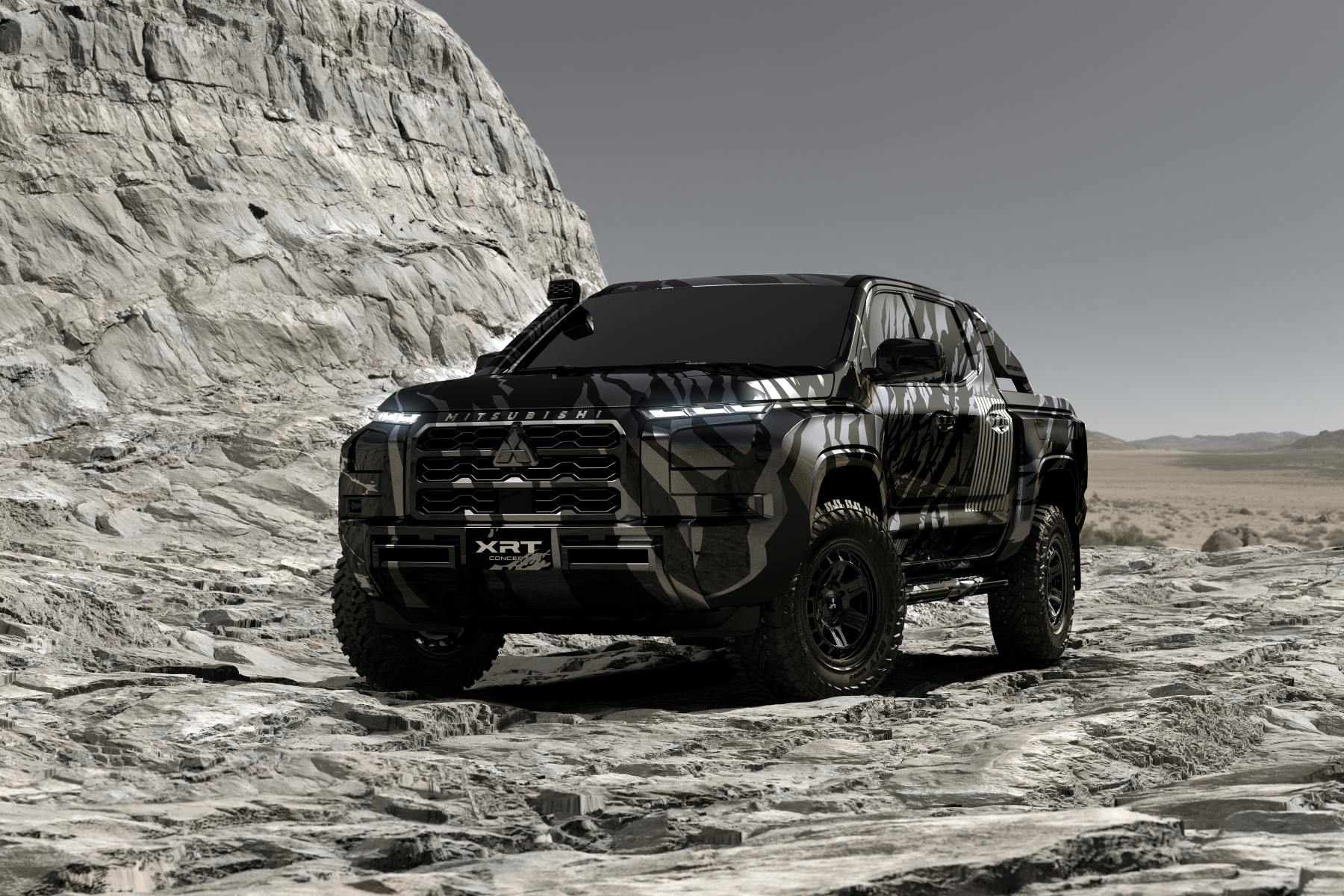
2. Partner companies
Team Mitsubishi Ralliart participates in the AXCR 2023 with the support of the following partner companies (in alphabetical order).
| Company | Support |
| CARROSSER Co., Ltd. | Support for development and supply of CUSCO front and rear suspension, and front and rear LSD |
| ENDLESS PROJECT Co., Ltd. | Supply of ENDLESS brake calipers, rotors and pads |
| ENEOS Corporation | Supply of engine oil |
| Fortec Motorsport Ltd | Supply of racing coolant, brake fluid |
| HANKYU HANSHIN EXPRESS Co., Ltd. | Support for transportation of special rally parts to Thailand |
| HKS Co., Ltd. | Support for development of rally specification engine |
| PT PERTAMINA | Sponsor |
| The Yokohama Rubber Co., Ltd. | Supply of GEOLANDAR M/T G003 (mud terrain tires for pickup trucks) |
| Mitsubishi Heavy Industries Engine & Turbocharger, Ltd. | Supply of turbocharger |
| Work Co., Ltd. | Supply of competition wheels |
3. About AXCR2023
Asia Cross Country Rally 2023, now in its 28th year, will begin with a ceremonial start on Sunday, August 13, in Pattaya, one of Thailand’s top sightseeing locations. The rally begins in earnest on the following day, Monday the 14th, with vehicles racing east, roughly parallel with the Cambodian border, entering Laos on Thursday the 17th, and reaching the goal on Saturday the 19th.
Over the course of the rally, drivers cover a total of roughly 2,000 km including over 1,000km of Special Stages. This year’s course also has a great deal of variety, including mountainous areas, thick forests, muddy roads, river crossings, and more. The difficult course is expected to put the road handling and durability of the rally cars to the test. This year, the event will be held in August the typical rainy season, and the muddy conditions are expected to be even more severe than last year.
Mitsubishi Motors to reveal the all-new Triton in Thailand on July 26 (20 June 2023)
Mitsubishi Motors will hold the world premiere of the fully redesigned Triton1 one-ton pickup truck in Thailand on July 26.
The Triton is Mitsubishi Motors’ global strategic model that has been well-received in the ASEAN region, Oceania, Latin America, the Middle East, Africa and other markets for its durability, robustness and drivability, as well as comfort and ride quality required for private use.
The all-new Triton – the sixth generation of Mitsubishi Motors’ midsize pickup truck – is updated with a beefed-up body and a powerful, horizontally-themed styling. At the front, the combination of daytime running lights resembling the sharp gaze of a hawk and a set of three dimensional headlights below emphasizes the impressive presence and robustness of the new model.
“The all-new Triton has been completely reimagined under the design concept Beast Mode, or audacious and daring,” said Seiji Watanabe, division general manager of design, Mitsubishi Motors. “While expressing the toughness and powerfulness expected of a pickup truck, the all-new Triton combines agility with the brand’s robust design to create an imposing look. Tough and reliable, the all-new Triton will make customers want to go on any adventure. Please look forward to seeing it in full this July.”
A video that takes a behind-the-scenes look at the development of the all-new Triton and a video message from the designer are now available on Mitsubishi Motors’ special website.
Special website for the all-new Triton:
https://www.mitsubishi-motors.com/en/products/triton
Mitsubishi previews next-gen Triton with XRT Concept at Bangkok International Motor Show (21 March 2023)
Mitsubishi Motors Corporation (hereafter, Mitsubishi Motors) will display the Mitsubishi XRT Concept – a concept car of the all-new Triton1 pickup truck planned for launch in fiscal year 20232 – at the 44th Bangkok International Motor Show 20233 to be held from March 21 to April 2.
The Triton is Mitsubishi Motors’ top-selling model manufactured at the Laemchabang Factory in Thailand and the company’s global strategic vehicle exported to about 150 countries around the world. With its first full redesign in approximately nine years, the all-new Triton will be the sixth generation of the brand’s midsize pickup truck. After the launch in Thailand in fiscal 2023, it will be released sequentially in the ASEAN region, Oceania and other global markets.
A concept car of the all-new Triton, the Mitsubishi XRT Concept is characterized by a fierce expression on the front and a robust hood that continues to the side with bold, horizontally-themed styling. Further, the concept car is fitted with front and rear over fenders as well as mud-terrain tyres, giving it the powerful drive to compete in grueling rallies and the dynamism to dash across the terrain. The body features a camouflage design inspired by lava rocks packed with condensed energy, and the sides have been adorned with a graphic of the 10-parallel line Ralliart brand icon that expresses Mitsubishi Motors’ passion for driving.
Asia Cross Country Rally 2023
At the Asia Cross Country Rally 20234, Team Mitsubishi Ralliart, which receives technical support from Mitsubishi Motors, plans to compete with a prototype cross-country model of the all-new Triton (Group T1 specifications) in its quest for a second straight victory. Hiroshi Masuoka, a two-time Dakar Rally champion driver in 2002 and 2003, will stay on as team director, and Mitsubishi Motors engineers will perform pre-testing and accompany the team to provide support at the rally. Mitsubishi Motors uses expertise gained from rallies as feedback in the development of its production vehicles, as it seeks to create vehicles with Mitsubishi Motors-ness, which deliver safe, comfortable driving enjoyment in any weather or road conditions.
”Fiscal 2023 is an important year for Mitsubishi Motors to accelerate our business in the ASEAN region, with the launch of a fully revamped Triton and an all-new compact SUV,” said Takao Kato, president and chief executive officer, Mitsubishi Motors. “The all-new Triton is going through final touch-ups in preparation for its release, as we have performed rigorous endurance tests around the world while also incorporating the know-how gained from rally activities. With the new vehicle launches as the centerpiece, we will continue our drive toward further growth. Please look forward to the future of Mitsubishi Motors.”
Notes
1. Triton is sold as L200 in some markets.
2. Fiscal 2023 is from April 2023 to March 2024.
3. March 21 is press day, and the show is open to the public from March 22 to April 2.
4. The Asia Cross Country Rally is the largest-scale cross-country rally event in the ASEAN region and has been held a total of 27 times thus far. This year, the competition is planning to cover a grueling course of over 2,000 total kilometers in mid-August, located primarily in Thailand and extending to neighboring Laos.

